This lesson plan can be used for all or some of the following purposes:
- introduce students to migration, nomadism, and dormancy, important methods used by living organisms to adapt to their environment;
- acquaint students with many of the concepts biologists use to describe those behaviors;
- work with the vocabulary and explore the derivation of some technical terms used to describe migration, nomadism and dormancy;
- confirm the use of the taxonomy for animal species;
- discuss the use of ultralight aircraft to reestablish lost migration patterns among birds; and
- provide an example of the process by which government can act through NEPA (the National Environmental Policy Act).
Time: Five to seven 55 minute class periods.
INTRODUCTION TO THE LESSON PLAN
The Migration Student Handout may be edited or supplemented with material from other sources. Teachers should decide which mix of written materials, lectures, and other information are best for their classes and suitable to the teacher’s mode of presentation. The Student Handout can be printed with or without the list of Diagrams. Lecture notes may be made by underlining or highlighting a portion of the Teacher’s Annotated Version of the Student Handout.
The diagrams, and references to visuals on the Internet, will help teachers present the material in a format that incorporates visual learning. If teachers have access to a system that will project computer images onto a screen, the Annotated Handout can be used as the basis for the projection of images. Teachers who do not have access to the Internet from the classroom can memorize the images onto a laptop or other computer and open them when appropriate. (In the United States, Congress has given explicit permission to teachers in public and non-profit educational institutions to use copyrighted images in their individual classrooms so long as no separate charge is made for their use. See Statutory Permission to Use Copyrighted Materials in U.S. Classrooms.)
TWM recommends showing the first 30 to 45 minutes of Winged Migration or some other documentary about migration to build interest in the subject. Fly Away Home is a good supplement but it’s probably too time-consuming to show both films. “Fly Away Home” can be assigned as homework or as an extra-credit project. One idea is to assign groups of five students and have them watch the film together after school or in the evenings. If “Fly Away Home” is used, make sure that there is a discussion or some other exercise that turns the negatives of this film into strengths. See Possible Problems Section of Learning Guide to “Fly Away Home”.
One way to organize class discussion for this unit is to show 30 – 45 minutes of Winged Migration and assign, as homework, reading the Migration Student Handout. The lecture is constructed by asking the class the discussion questions. The Discussion Questions section contains suggested queries to put to the class proposed answers and references to illustrations from this Lesson Plan or the Internet to show students during the discussion. Many of these questions will be repeated in the comprehension tests.
TEACHERS’ ANNOTATED VERSION OF THE STUDENT HANDOUT:
NOTES ON MIGRATORY, NOMADIC, AND DORMANT
BEHAVIOR IN LIVING ORGANISMS
A version of the student handout in Microsoft Word® suitable to be printed and distributed to students can be found at Migration Student Handout. Teachers are encouraged to modify the Migration Student Handout by adding information, deleting sections, or otherwise adapting it to the needs of their students.
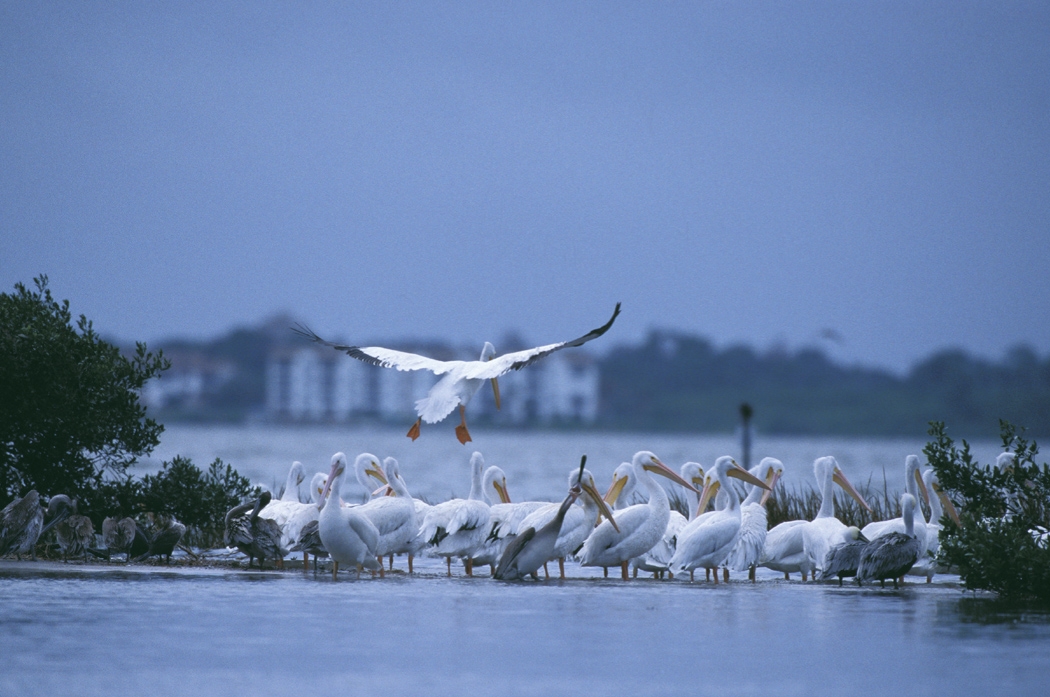
White Pelicans
Introduction
A biome is defined as an area characterized by distinctive climate and soil conditions and a distinctive biological community adapted to those conditions. Examples include desert, grassland, tundra, rain forest, and coniferous forest.
The term “migration” can refer to the periodic movement of part or all of an animal species between biomes. Birds who nest in the far north during the summer and fly hundreds or thousands of miles to winter in the south are classic examples of animals that migrate between biomes.
Migration usually occurs in response to changes in the seasons (cold and warm, wet and dry) which generally affect food availability. Migration of animals from one biome to another is an important process in the natural world. For example, about 650 bird species nest in the United States. Approximately 520 of these species migrate south to spend the winter.
From an evolutionary standpoint, most migratory animals change biomes to reach locations in which food is more plentiful than in their home range or in which there are safer nesting grounds. A population of animal that has access to more abundant food or safer nesting grounds will do better than a population of animals that does not have these advantages.
The word “migration” has a number of other meanings. To distinguish what we will be studying in this unit from other meanings of the word migration, we will call it “biome migration”.
TEACHER COMMENT: Other meanings of the word migration include: the movement of people from one place or country to another and the nonrandom movement of an atom or radical from one place to another within a molecule. As we shall see, the word “migration” is also used to refer to the movement of organisms within a biome, that is not periodic or not for the purpose of increasing available food or to enhance reproduction. For example, migration is used to refer to the almost constant movement of waterborne anaerobic bacteria (single celled organisms that thrive in oxygen poor environments) away from water or mud that is saturated with oxygen and toward water or mud that has a lower concentration of oxygen.
In this handout, we will compare biome migration to nomadism and dormancy. Nomadism refers to animal populations that frequently move in search of food or water usually within a single biome. Nomadic and biome migratory behaviors are not mutually exclusive and many animals (such as large land mammals) exhibit behavior that has characteristics of both.
Help students visualize the differences between migration and nomadism with the Migration Definition Diagram.
We will also explore dormancy, the inverse of both biome migration and nomadism. Dormancy occurs when organisms adapt to their environment not by changing location (as in biome migration or nomadism) but by changing the organism itself. Examples of dormancy are animals that hibernate and reduce their metabolism to conserve energy or moisture. There are also organisms that develop protective coatings to insulate themselves from extremes of temperature or other inhospitable environmental factors and to allow better dispersal of the organism.
TEACHER COMMENT: Ask the class for a definition of the word inverse: “reversed in order, nature or effect.” The class may be familiar with the inverse in mathematics: -2 is the additive inverse of 2, because their sum is zero. 1/4 is the multiplicative inverse of 4, because their product is 1. The term inverse will be used several times in this lesson plan and in the comprehension tests. How is inverse different than opposite? Inverse needs to be reversed only in some ways, whereas opposite is something “completely” different. Most things are inverse; very few are opposite.
Biome Migration: Seeking Evolutionary Advantage Through More Food and Enhanced Reproduction
Most animals migrate horizontally, moving over the surface of the Earth toward areas in which there is a greater abundance of food. However, some migration is primarily vertical, as when fish move to different depths of water or when birds or land animals move from mountains to lower elevations in nearby foothills or valleys.
The periods of migration are usually annual but they can also be twice a year or they can extend over many years. Some species migrate many times during the lifetime of an individual. In other species, individuals migrate only once, reproducing and then dying when they reach the end of their journey. In some species the round trip is divided between generations. One generation migrates to an area in which they reproduce but the return trip is made by their offspring.
Biome migration is usually based upon cycles of surplus and scarcity which result from seasonal changes in temperature. Animals that are mobile move to areas in which food is plentiful and thereby obtain an evolutionary advantage. See Model for the Evolution of a Migratory Flock below. The classic example of migration is provided by birds with a north/south migratory pattern in the Northern Hemisphere. In the summer, the far north explodes with insect and plant life. In addition, there are fewer predators in this area than in more southerly climates. Plentiful food and fewer predators result in excellent breeding grounds for many types of birds. By the end of the summer, when food is getting scarce in the far north, the birds migrate south to their home ranges. In the spring they go north again to nest and feed.
Biome Migration Among Birds
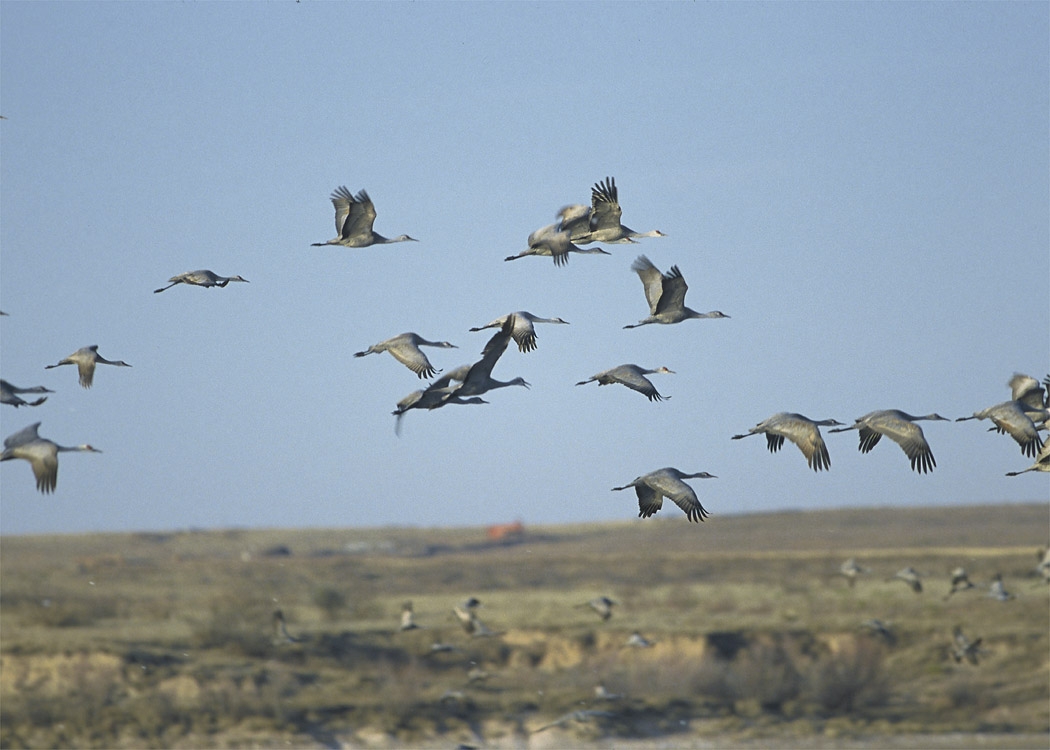
Sandhill Cranes
The Basics of Bird Biome Migration
The longest and most dramatic biome migrations are undertaken by birds. Birds are the most mobile animals. They are also among the most motivated to seek new sources of food because their high metabolic rate requires an abundant supply of energy. (The heart of a Ruby-throated Hummingbird beats 500 times a minute; a healthy human heart rate is between 60 and 101 beats a minute).
All birds evolved from a common ancestor. In addition to high metabolism, birds have feathers, hollow bones, horny beaks, and large yolked hard-shelled eggs. While some birds no longer fly, their ancestors did.
Birds are a “class” of animal species. You have probably already studied the taxonomy of animal species and we will refer to it several times in this handout. Birds are classified as:
Kingdom
Animalia
Phylum
Chordata
(animals with spinal cords)
Subphylum
Vertebrata
(animals with spinal cords contained within vertebrae)
Class
Aves
(birds)
Most species of birds migrate at night (“nocturnal” migrators) while some travel during the day (“diurnal migrators”). The reason that most birds migrate at night is that during the day the Sun warms the Earth which heats the air near the ground. As the hot air rises, it creates disturbances in the air, making flying for birds who gain height by flapping their wings more difficult. In addition, the temperatures are cooler at night and predators less frequent. On the other hand, raptors, cranes, and storks, species which use thermal currents to gain altitude, migrate during the day. They make good use of the very updrafts that make diurnal migration difficult for other birds. Some species of birds fly during the day because they need to eat insects that they can catch during the day. Examples are swallows, swifts and nighthawks.
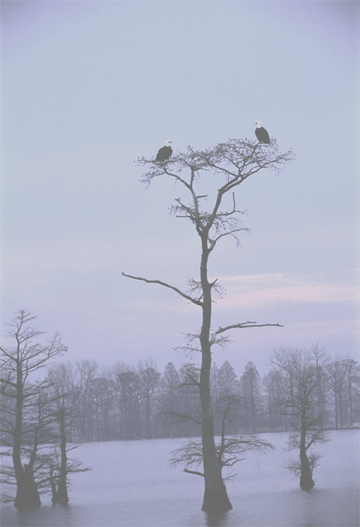
Bald Eagles – National Park Service
Some species of birds journey during specific parts of the day, such as sunrise or sunset. Even within species, different populations will migrate at different times of the day. Certain species of birds are diurnal migrators at times and nocturnal migrators at other times. Land birds that fly over oceans or seas will fly day and night until they reach land. Other birds, including raptors and storks, are limited to migration by flying over land where they can take advantage of thermal updrafts. Some raptors delay their migration so that they can feed their young the meat of other migrating birds.
While the vast majority of birds transport themselves by flying, some birds, such as the ostrich, emu, and penguin walk or hop. Penguins and the Razorbill are most at home swimming.
Feathers and hollow bones are the primary adaptive techniques allowing birds to fly. Feathers are flexible, strong, and light. They are excellent insulators. Birds use them to control the flow of air around their bodies. Hollow bones keep birds light enough to fly.
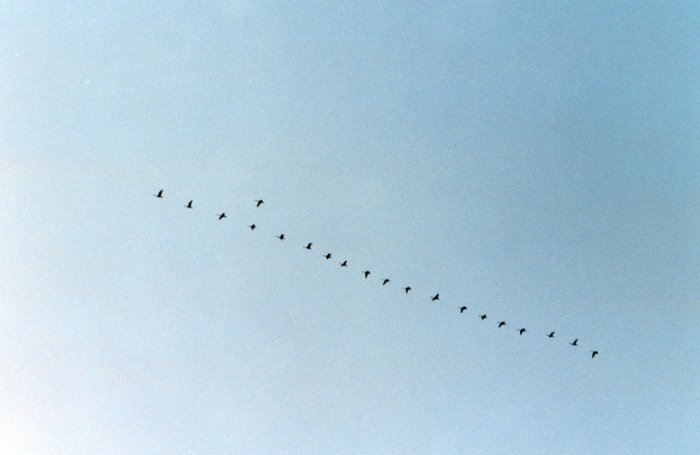
Canada Geese in the V formation, NOAA Photo Library
The use of a formation by which birds fly a short distance behind the wing tip of the bird in front of them (often called the “V” or squadron formation) saves energy, allows the birds an unobstructed view, and permits them to communicate. The strongest and most dominant bird takes the lead position. When she flaps her wings, the down-beat forces air to roll off of her wing tip, creating a vortex that is similar to the wake of a boat. The bird behind her surfs on this vortex making his or her flight a little easier. In this formation, each bird in turn, as it flaps its wings, assists the birds behind it. Birds arrange themselves so that the weakest birds are last. In this manner the entire flock, from the strongest bird to the weakest bird can fly, at the same speed. It has been estimated that geese can fly 70 percent farther by using the V formation rather than by flying solo.
TEACHER COMMENT: The U.S. Air Force, in experiments with F-18 fighters, has shown that there is a 20% reduction in fuel consumption when one plane flies within the vortex caused by the wing tip of another plane.
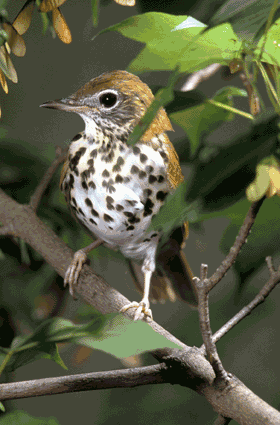
Wood Trush – Crosses Gulf of Mexico U.S. Fish & Wildlife Serv.
During their migrations, birds that fly long distances primarily by flapping their wings can cross oceans and seas from which they can get no food or water. For example, the tiny Wood Thrush crosses the Gulf of Mexico. The Arctic Tern flies from the Arctic to the Antarctic and back, a phenomenal round trip that can be as long as 22,000 miles (35,400 km) per year. The long-tailed jaeger, another sea bird, flies 5,000 to 9,000 miles in each direction. Journeys of 2,500 miles per year are made by some cranes. The tiny barn swallow flies more than 6,000 miles in its annual migration.
The Rufus Throated Hummingbird makes the longest migration of any animal in terms of body length, at about 48,600,000. Ruby-throated Hummingbirds, tiny birds less than 3.5 inches in length and weighing only 3.5 grams, travel to staging places in the Gulf coast of the United States. There they feed on the pollen of flowers and gain weight. When they have stored enough fat for the journey and when conditions are right, they set off. Flying sometimes more than 30 hours without setting foot on dry land or on a branch, they travel 500 miles non-stop to the Yucatan peninsula. Sources include: Questions and Answers About Hummingbirds from Operation RubyThroat and Migratory Pollinators Website of the Arizona-Sonora Desert Museum.
What triggers migration? Physiological changes that allow birds to gain fat for the journey are governed by the pituitary and thyroid glands. However, these changes only allow birds to store the extra energy needed for the migration. Thus, the trigger for starting the long flight must be something sensitive to conditions which change every year. Possibilities are: the date of the arrival of spring, the timing of storms, the flowering of plants, the hatching of insects, increases in foliation, and the availability of food.
Almost certainly, different species have different sensitivities to climactic and environmental conditions. The Woodcock, Snipe, Lapwing, Starling, and Lark appear to depend on temperature and barometric pressure. Others, such as the Swift, Cliff Swallow, Baltimore Oriole, and Short-tailed Petrel are less weather dependent and their migrations occur with remarkable regularity each year. This is a very undeveloped area of study and scientists don’t know a lot about it.
DISCUSSION QUESTION:
In the summer, Emperor penguins live and feed in Antarctic ocean waters. In the Antarctic fall, March and April, they go onto the pack ice to pair up and to breed. The mother lays the egg which the father (still at the breeding ground on the pack ice) incubates in a special insulated pouch. This takes most of the Arctic winter. Penguins eat fish and other animals found in the ocean. There is no food for them on the pack ice. After the mother lays the egg, she returns to the ocean to feed. When the egg hatches, the mother travels back over the pack ice to feed the chick with food regurgitated from her stomach. By that time the father will have been without food for about four months. The mother then takes responsibility for the chick while the starving father returns to the sea. He comes back to the breeding ground with a stomach full of food for the chick. The parents then take turns going back and forth from the breeding ground on the pack ice to the ocean, bringing food for the chick. This continues until the summer (December or January) when the chick is old enough to fend for itself. Certainly, the ocean and the pack ice are different biomes. Do Emperor penguins engage in classic biome migration?
SUGGESTED ANSWER:
No. Emperor penguins do not breed and hatch their eggs during the spring and summer in which they take advantage of the food provided by the explosion of life that occurs when temperatures warm. They reproduce in the fall and winter in some of the harshest conditions on Earth. See March of the Penguins.
Flyways and Funnels
A flyway is a route used regularly by migrating flying animals such as birds, bats, or butterflies. Flyways are like rivers, with less important common migration routes or migration routes of individual species feeding into them like tributaries. Most flyways run generally north/south between northern breeding grounds and southern wintering grounds. Some of the generally north/south flyways have significant east/west movements. Flyways usually follow geographic features such as river valleys, coastlines, and mountain ranges.
Flyways are more pronounced in North America than in any other continent. In North America, they are usually classified into four: the Atlantic Flyway, the Mississippi Flyway, the Central Flyway and the Pacific Flyway. North America before the population of the continent by Europeans, had broad expanses of forest, tundra and wetlands that were ideal for migratory birds. This is changing as the wetlands are filled in, the forests cut down, and pollution increases. Some biologists contend that there are only three flyways combining the Central and Mississippi. Others find it convenient to refer to seven flyways in North America.
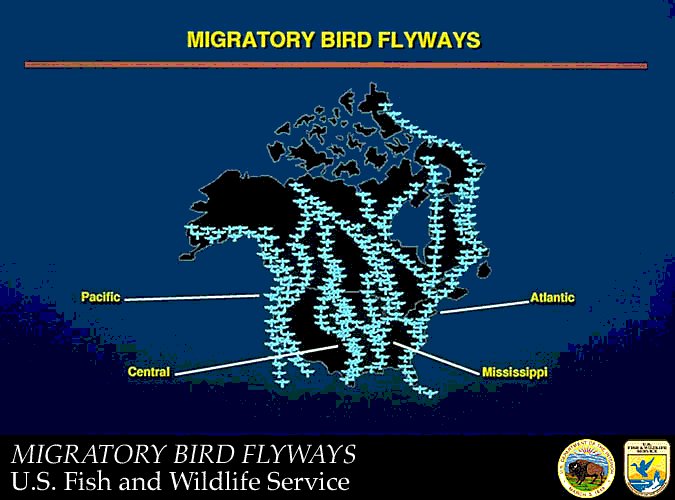
All North American flyways, except for the Atlantic Flyway, converge in Mexico or Central America. (Some long distance migrators fly from the far north, over the Mississippi or Central flyways, directly across the Gulf of Mexico to South America.) The Atlantic Flyway crosses the tip of Florida, the Caribbean Sea, and ends up in South America. For the Atlantic and Pacific Flyways the difference in temperature between land and sea gives rise to constant breezes which the migrating birds can use to help them keep their elevation. Birds use the coastline to orient themselves and find their way. The Sierra Nevada and the Appalachian Mountain ranges generally run north/south and generate updrafts as they deflect winds. There is (or was) abundant food along the shorelines and in the wetlands. The Mississippi River system also provided another north/south conduit and wetlands that provided food. Unfortunately, as wetlands have been destroyed by development and pollution increases, the viability of these flyways has diminished.
The flyways of Eurasia and Australasia include: the East Asian-Australasian, the Central Asia/India, the West Asia/Africa, the Mediterranean/Black Sea and the East Atlantic Flyways.
A visual of the Asian-Australasian Flyway can be downloaded from the website of the Australasian Waders Study Group.
In South America there are established migration paths from near the southern tip of the continent. Various routes of migration go north into the Amazon Basin, north to the Plate River in Argentina, and, skirting the Andes, north to Central America.
Flyways can be only a few hundred meters wide at certain points, such as mountain passes and the crossing points of water bodies. These strategic points are called funnels. In other places, flyways can be hundreds of kilometers wide. Birds on different migratory flyways may share stopover sites and breeding areas. Some species of birds don’t always fly the whole course of a flyway, stopping when they reach their home range.
Large bodies of water such as oceans and seas do not create the thermal updrafts needed by raptors, storks, cranes and some other birds to gain altitude for long distance migrations. Mountains do not provide good consistent thermals. Thus, birds that use updrafts to gain altitude are forced to keep to flat land areas and cross large bodies of water at their narrowest points.
During migration, massive numbers of raptors pass through funnels such as Gibraltar (where Europe and Africa almost touch at the entrance to the Atlantic Ocean), Falsterbo (where the Scandinavian Peninsula is closest to the Danish Islands that provide an easy route to the European land mass) and the Bosphorus (a narrow band of land between the Black Sea and the Sea of Marmara). At each of these funnels, hundreds of thousands of birds that use thermal updrafts to gain altitude in their migrations cross in a narrow stream. They spread out when the land mass widens. For example, the birds coming from Eastern Europe through the Bosphorus spread out through Turkey and around the eastern end of the Mediterranean Sea only to bunch together again to cross the north end of the Suez Canal into Africa. In the Americas, Vera Cruz, Mexico is a vital link in raptor migration. Birds of prey migrating between North and South America can’t find good thermals in the mountains west of Vera Cruz. They can’t fly in the Gulf of Mexico (more specifically the “Bahia de Campeche”) to the east because oceans do not create thermals. They fly along a strip of land along the coast. In Vera Cruz, that strip is only 25 miles wide.
Show these locations on a map or globe.
Teacher Discussion About the Potential Role of Migrating Birds in Spreading Avian Flu
Influenza A viruses are commonly found in birds. Most are not pathogenic. They don’t kill the birds and normally don’t infect species other than birds. However, on occasion one of these viruses will mutate and cause influenza outbreaks in humans. Some forms of influenza viruses cause severe illness and death in birds and in humans. These are called Highly Pathogenic Avian Influenza (HPAI). Between 1996 and 2005 various HPAI strains of the subtype HPAI-H5N1 infected approximately 110 people in East and Southeast Asia, killing about half of them. (The countries affected included Cambodia, China, Indonesia, Japan, Republic of Korea, Lao PDR, Malaysia, Thailand and Viet Nam.) All of the people who contracted HPAI-H5N1 influenza had some direct connection with chickens or other birds that had been infected with the virus. This virus has never been known to move between people. However, viruses mutate often and while it is unlikely, it is possible that the virus could mutate so that it can be passed between people. When that occurs, a pandemic of this highly pathogenic flu could occur throughout the world in a very short period of time.
Devastating outbreaks of HPAI-H5N1 usually occur among poultry and ducks that are kept in large numbers at high densities. For several years, the H5N1 virus has been controlled when public health officials killed poultry populations that were infected. Hundreds of millions of birds have been killed. However, starting in May 2005, the virus expanded its range and has now been reported in Russia, Turkey, Romania, and Indonesia. The list of countries reporting infected birds grows almost daily. It appears that the spread of the virus is linked to the infection of migratory birds. In mid-2005 there were two major kill offs of migratory birds: 6000 at Qinghai Lake and about 90 birds in lakes in Northern Mongolia. These locations are places where several different species of migratory birds stop on their migration routes.
Surveys carried out in Europe indicate that up to 20% of fecal samples collected from more than 15 species of migratory birds contain low pathogenic avian influenza (LPAI) viruses. Some of these viruses are subtypes H5 and H7 which may mutate to become HPAI (highly pathogenic). These mutations seem to take place primarily in situations where rapid virus duplication occurs, such as in domestic poultry farms.
This is a breaking story. There will be newspaper stories and magazine articles on this topic and the efforts to defend against the anticipated pandemic. Collect these and use them in this discussion or assign students a research project to find the latest news and write a report.
Bird Navigation
All navigation is dependent upon two things: a map to show the traveler where to go and a compass to indicate the direction of travel. Scientists have studied navigation capacities of birds in two contexts: homing behavior and migration.
Birds have amazing powers to return home, even if relocated thousands of miles away. For example, a Laysan Albatross returned to Midway Island in the Pacific after it was released at Whidbey Island, Washington, a journey over open sea of some 3,200 miles (5,100 km). The bird made the trip in 10 days. Other examples are: a swallow: 1,100 miles(1,800 km); a Manx Shearwater: Massachusetts to Britain, 3,050 miles (4,900 km) across the Atlantic in 12 1/2 days; and a starling 500 miles (800 km).
A bird taken from its home range will fly in a spiral pattern until it finds a landmark it recognizes. It then heads straight home. Topographic features that might be used by birds are mountains, rivers, and coast lines. To help find their way home, birds have also been known to use ecological and climactic markers such as vegetation zones, prevailing winds, and air masses of different temperature and humidity. Birds can also obtain guidance from their sense of smell. A good example are Homing Pigeons. They can remember the different odors that reach their lofts on winds from varying directions. For example, if a pigeon’s loft has a particular scent that comes to it on westward winds and it is transported to the west away from the source of the scent, it will fly in a direction that makes the scent stronger, i.e. to the east, to return home.
The location and direction of the Sun, the position and location of the stars, and the Earth’s magnetic field are also used by birds to guide them on their journeys. No one is sure exactly how birds use these navigational tools and in what combination or if these are the only aids to navigation that birds use.
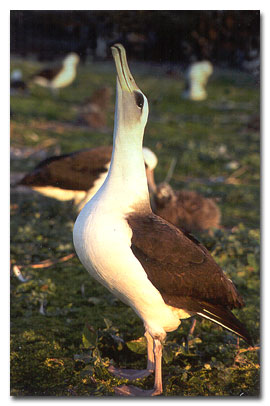
Laysan-Albatross Sky Pointing
a mating ritual behavior
Birds are on the same classification level as mammals, fishes, reptiles, and amphibians. In other words, they are all animals with spinal chords contained within vertebra. The classifications below subphylum are: “orders”, “families”, “genera”, and finally “species”. More of this later.
In your lecture, help students visualize the biological classification systems with Taxonomy for the Class Aves (Birds).
Variations on the basic themes of bird migration appear to be infinite. In many species of birds some populations migrate and others don’t. Within the same populations of certain species the migration can be partial, with some birds who live in the same home range migrating while others reside there year-round.
In some partially migrating populations, only the smaller juvenile birds will migrate while the adults stay put in the winter or the females migrate while the males stay put. For example, the Chaffinch population in Britain does not migrate, while in Scandinavia the female Chaffinch migrates but not the male. In some species some individuals may winter in one area one year and the next year take another migration route and winter in another area. Some birds migrate in families. In some species, populations migrate at different times and along different routes. Some species migrate long distances without stopping, while others migrate in stages taking breaks to rest and feed along the way. Most bird species migrate primarily north/south but there are species which migrate primarily east/west, often seeking the more moderate climate of the seacoast during the winter. For visual learners, teachers may want to draw a diagram on the board showing the entire population as a circle divided between resident and migratory populations.
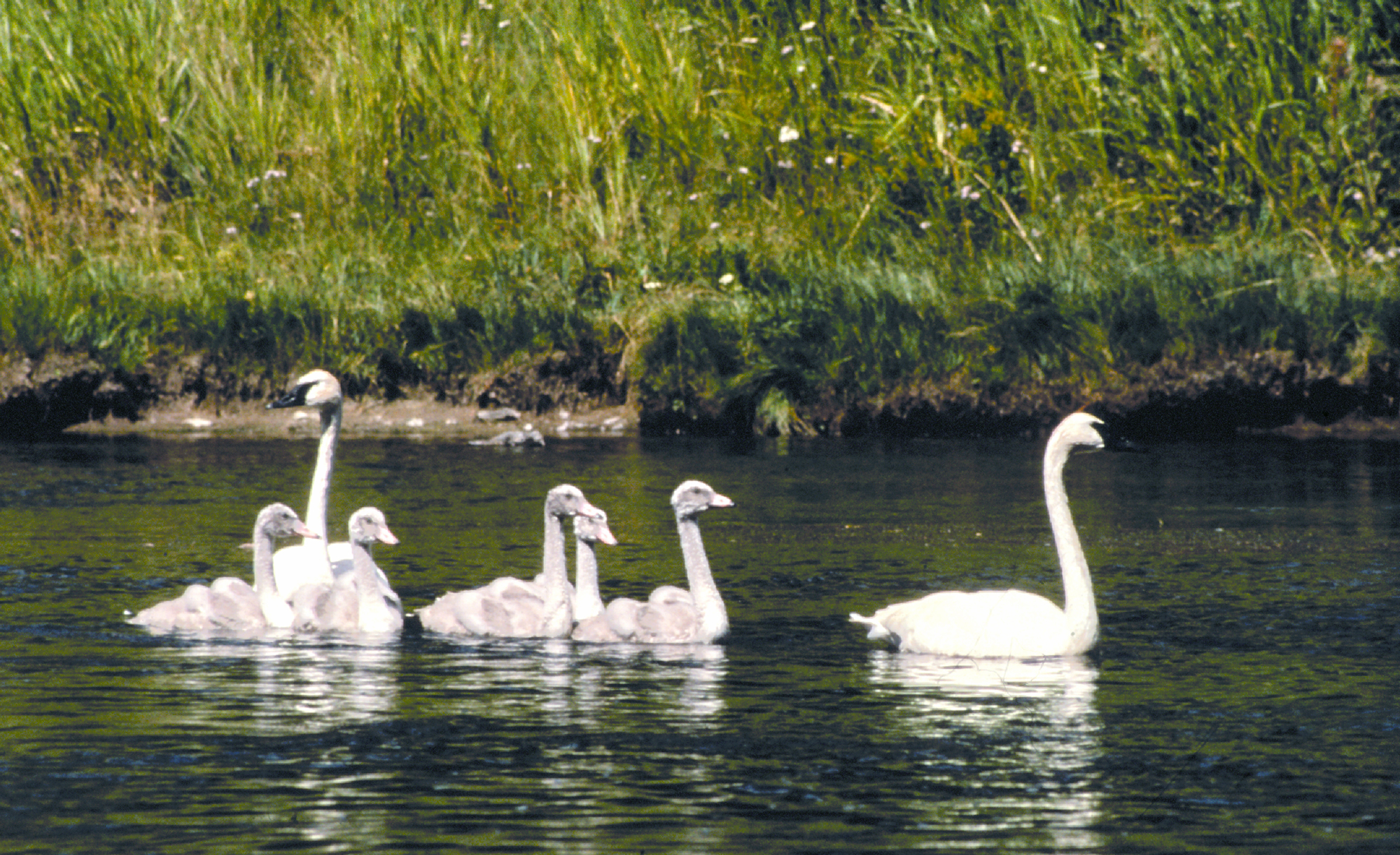
Swans migrate in families
National Park Serv.
Taxonomy of the Ruby-throated Hummingbird. The class of animal species called Aves (which means “bird” in Latin) contains about 30 orders (for example – waterfowl, hummingbirds and swifts, penguins, and owls).
The 30 Orders of the Class Aves include about 180 families. The Order that includes hummingbirds and swifts (Apodiformes), contains three families: swifts, crested swifts and hummingbirds. Apodiformes are birds with very short legs and very small feet. They are among 180 different Families within orders of the Aves Class. Each of these Families are divided into Genera (plural for Genus). There are about 2,000 Genera, in the 30 different Orders and 180 separate Families in the Class Aves. More than 100 of these Genera are in the hummingbird Family (called Trochilidae). The Genus in the hummingbird Family that includes the Ruby-throated Hummingbird is called Archilocus. It contains two Species. In total there are about 10,000 different Species within the Class Aves, i.e., there are 10,000 species of birds.
AVES —> 30 Orders —> 180 Families —> 2,000 Genera —> 10,000 Species of birds.
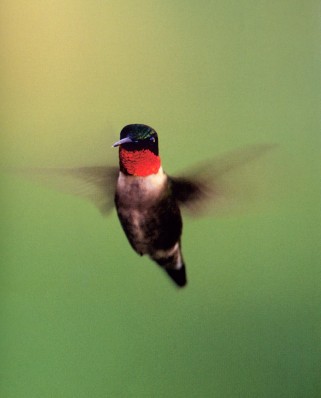
Ruby-throated Hummingbird
National Park Service Photo
The taxonomy for the Ruby-throated Hummingbird is:
Kingdom: Animalia —> Phylum: Cordata —> Subphylum: Vertebrata —> Class: Aves (birds) —> Order: Apodiformes (hummingbirds and swifts) —> Family: Trochilidae (hummingbirds) —> Genus: Archilocus (Ruby-throated hummingbirds) —> Species: Archilocus Colubris (Ruby-throated Hummingbird)
Migrating birds vary their altitude to take advantage of weather conditions and wind currents. To fight a headwind, most birds stay low, where ridges, trees, and buildings slow the wind. Birds will ride a tailwind as long as possible. Bar-headed Geese have been recorded flying across the Himalayas at 29,000 feet, higher than Mount Everest. Other species seen above 20,000 feet include the Whooper Swan, the Bar-tailed Godwit, and the Mallard Duck.
Some birds who are mountain or moorland breeders, such as the Wall creeper and White-throated Dipper, migrate by changing the elevation of their range to leave colder higher ground for lower warmer elevations. Some birds, such as Merlins and Skylarks, will move further to the coast which has a milder climate or to a more southerly region. In periods of extreme cold, birds that are otherwise non-migratory will move. An example is the Chaffinch which is not migratory in Britain but which in periods of unusually cold weather will move south or to Ireland.
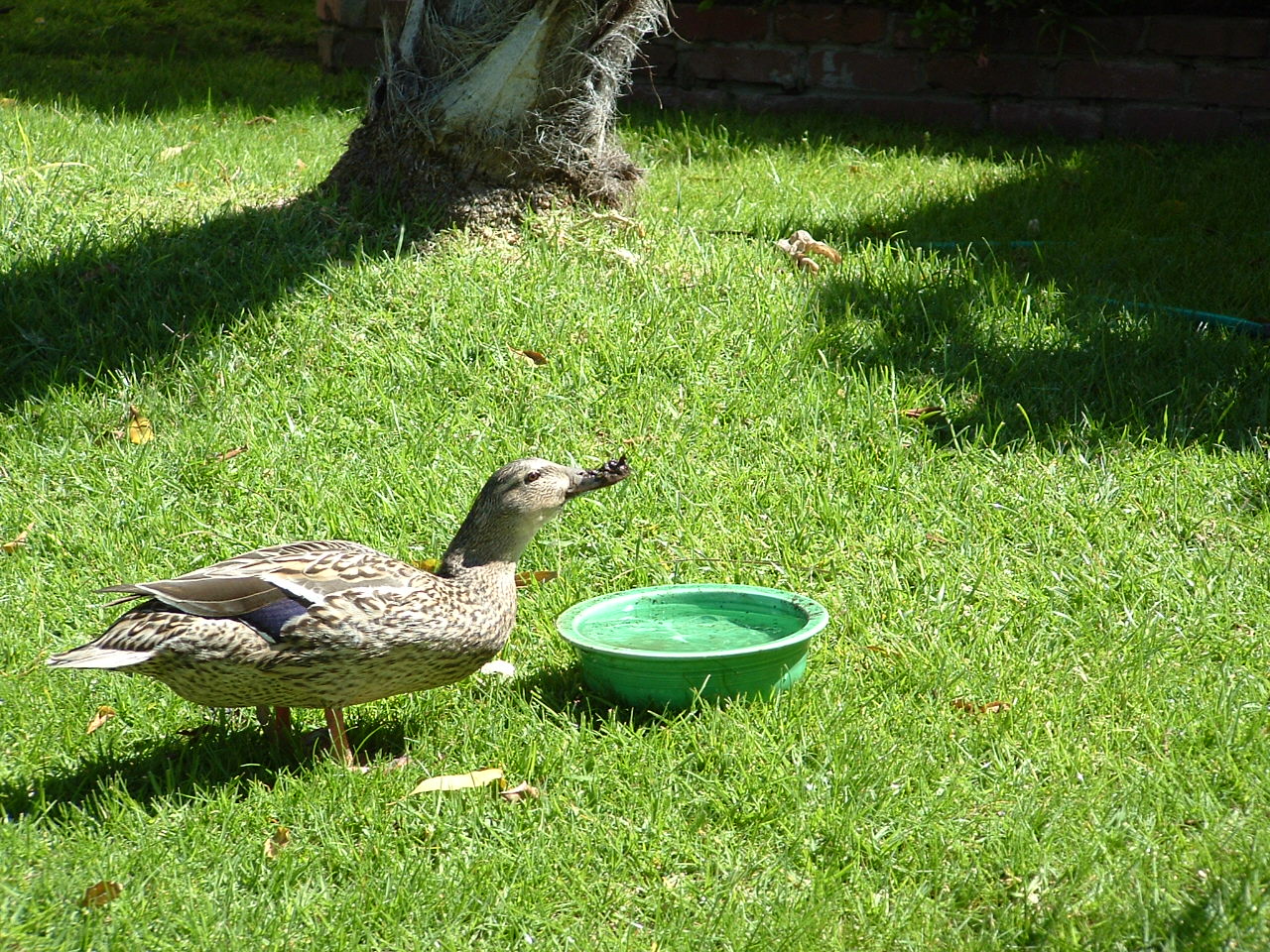
Migratory Mallard Drinking, Los Angeles, March, 2005
This species can fly at elevations of 4 miles
Nor do scientists know how birds use the Sun as a navigational tool. Birds may know instinctively or by memory what location the Sun should be in the sky at particular times of the year or the day and fly toward locations in which that will occur. The Sun, would in effect, act as a compass. Alternatively, birds may calculate the angle made by the plane through which the Sun is moving in relation to the horizontal, knowing by instinct or memory what it should be in their home area. In the Northern Hemisphere, the highest point reached by the Sun always lies in the south and is reached at noon. This could show the birds direction and time allowing them to compare the curve of the Sun’s movement with circumstances in the bird’s usual habitat.
Some birds use the magnetic field of the Earth to allow them to fly in a constant direction no matter where they are released with respect to their home area. Some scientists believe that birds also use the magnetic field of the Earth to sense their location. It is likely that small crystals of magnetite inside the bird’s bodies act as a compass.
TEACHER COMMENT: Birds aren’t the only animals to travel long distances to return home. Cats have been known to travel long distances to return home. (Ninja, a cat, returned to his home in Washington State in 1996 after having been moved by his family to Utah a year earlier. The distance was 850 miles. A cat named Sooty found his way back to his old home in England after being moved more than 100 miles away.) Sources: Homing Instinct from PBS and Sea Snake Homing Instinct Could Nix Translocation.
Model for the Evolution of a Migratory Flock and a Migratory Species
How are migratory patterns established? It begins with a permanent non-migratory resident population that expands its range due to competition within the species. Pressures for migration start if the range expands into an area in which there is a lot of seasonal change and which provides more food during the breeding season (the far north in the summer) but a harsher climate and reduced food availability during the non-breeding season (the far north in the winter). Individuals breeding in these new regions at the fringe of the species’ distribution (the proto-migrants) will be more productive because there is more food in the regions in which they breed. Their problem is to improve their chances of survival during the non-breeding season, in which the climate in the fringe areas is harsher and provides less food. Those birds that return to their ancestral range during the non-breeding season to take advantage of the food that is there will have the advantage of enjoying the best food in the breeding season (the north in summer) and the best food in the non-breeding season (the south in winter). As the fringe of the range expands outward, the journey back to the ancestral range to feed during the non-breeding season becomes longer and longer.
Because a migrant population gains an advantage on both its breeding and wintering range, it becomes more abundant, while the resident, non-migratory population becomes proportionately smaller and smaller in numbers. If changing environmental conditions become increasingly disadvantageous for the resident population or competition for food becomes more severe, the resident population could eventually disappear, leaving the migrant population as characteristic of the species. Or, the two flocks can separate physically. Eventually, they will become different species of birds. These stages in the evolution of migration are represented today by species which are permanently resident, partially migratory, and fully migratory. As for all adaptations, natural selection continues to mold and modify the migratory behavior of birds as environmental conditions perpetually change and species expand or retract their geographic ranges. Hence, the migratory patterns that we observe today will not be the migratory patterns of the future. Visual learners will benefit from the Evolution of Migration Diagram This section adapted from Evolution of Migration from the U.S. Geological Service.
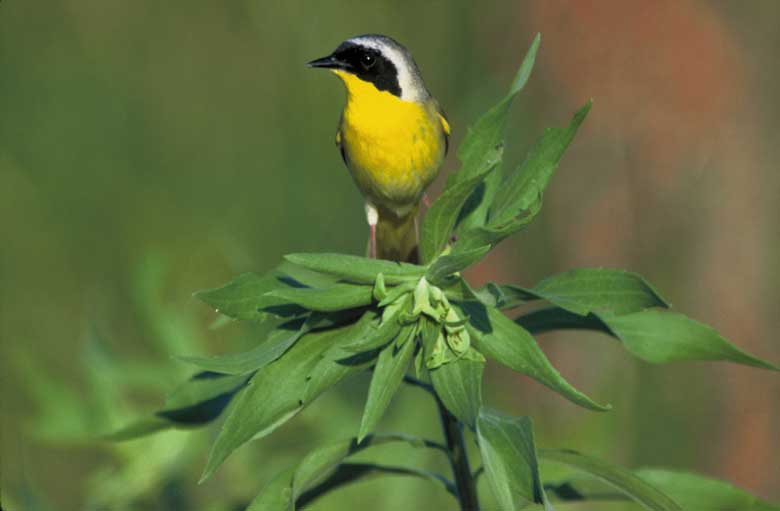
The Common Yellowthroat of the Atlantic coast is a good example of the process of migratory and non-migratory flocks separating. Birds that breed in the most southern part of the species’ range in Florida are largely non-migratory, whereas populations that breed as far north as Newfoundland migrate to the West Indies in the winter, well removed from the resident population in Florida. Eventually, flocks of birds of the same species which are physically separated will develop into different species.
Dr. Craig Stanford of the University of Southern California described this process in an interview with TeachWithMovies.org using chimps, bonobos and squirrels as examples:
TWM: What about the bonobos and the chimps? Are they super close genetically . . . and their ranges, do they overlap?
Dr. Stanford: Yes, they are very close because they’re basically both variants of the same animal. And no, the ranges don’t overlap, they’re adjacent. If you go back a million and a half years or maybe less, you’d find there was one ape that looked like the two of them combined, and that what almost certainly happened is that this huge river, the Congo River, which is like the Mississippi, probably changed course at some point and divided what had been this ape’s range into two pieces, most of it to the north of the river and then a little bit of it in the south. Those two animals were the same animal, and then over thousands of generations, you know, mutations happened. There was no more gene flow. There was no migration back and forth across the river. As a result the chimpanzees were isolated in the north; the bonobos to the south.
TWM: Just because of the separation of the river?
Dr. Stanford: Well, that’s the way most species are formed, right? That’s why, if you go to the Grand Canyon and you go to the North Rim and compare the animals there to the South Rim animals you find that there are these slight differences. The squirrels on the North side are very similar to the ones on the South side. You look at their genetics and you find that they’ve been separate from the squirrels on the other side for exactly the length of time the canyon has been there. They go their separate ways. There’s no longer any contact. A mutation happens here that doesn’t happen there, . . . there’s no more migration. The genes don’t cross the canyon, so, a thousand years later you have squirrels with pointy ears here and not there.
Bird species are extremely old. The continents were much closer 50 million years ago than they are today. As the continents drifted apart, migration patterns changed. In addition, in the “recent past”, the last two million years, there have been approximately six ice ages. These, too, bring about changes in the location of breeding areas and winter feeding grounds.
While migration confers definite benefits, there are risks as well. A major risk is predation, particularly from man. However, other birds will also prey on migrants. There are also storms and the risk of losing direction over a desert or an ocean. An example of the risks is shown by the Hawaiian Goose. These are Canada Geese who were blown or flew off course by about 2000 miles. Fortunately, they sighted the Hawaiian Islands and landed there but were never able to make it back to the mainland and their normal migration routes. Isolated in the tropics for millions of years, they have adapted to higher altitudes among the mountains of Hawaii and lost most of the webbing in their feet. They have now become a resident, non-migrating population. If they are not already a separate species of geese they will become one. You can see them at the Waimea Canyon. Source: The Ultimate Kauai Guidebook 4th Edition, by Andrea Doughty & Harriett Friedman, 2003, Wizard Publications, Inc., Lihu’e Hawai’i, pp. 90 & 91.
TEACHER COMMENT: There are birds that flew over Hawaii, stopped their migration at that point, and now use it as their winter home. In the summer, they go back to their breeding ground in the north. Examples are: The Northern Shoveler, Lesser Golden Plover or Kolea, Sanderling or Huma-Kai and the Northern Pintail
Migration patterns are affected by man-made changes in the environment such as deforestation, draining swamps and marshes, and urban development. These eliminate fields for foraging and prey for hunting. Natural causes also affect migration patterns. These include climate changes (particularly ice ages) and shifts in the positions of islands and continents as a result of tectonic drift.
Reintroducing Migratory Behavior in the Eastern U.S. Whooping Crane Flock
Whooping cranes are beautiful and graceful birds. They are the tallest birds that nest in North America, the male reaching 4.5 feet (1.5 meters) in height. Whooping cranes have a long neck, a long dark pointed bill, and long thin black legs. The wingspan of an adult Whooper measures six feet (2 meters). Its body is white and its wings are white except for the tips, which are black.
Whooping cranes fly long distances like a glider. Gaining elevation from thermal updrafts, they spiral down to about 70 meters above the ground until they find a new updraft. Spiraling and gliding conserves energy and allows these large birds to travel long distances. Whooping cranes in flight can be distinguished from other birds by their long necks extended forward and legs that trail straight behind.
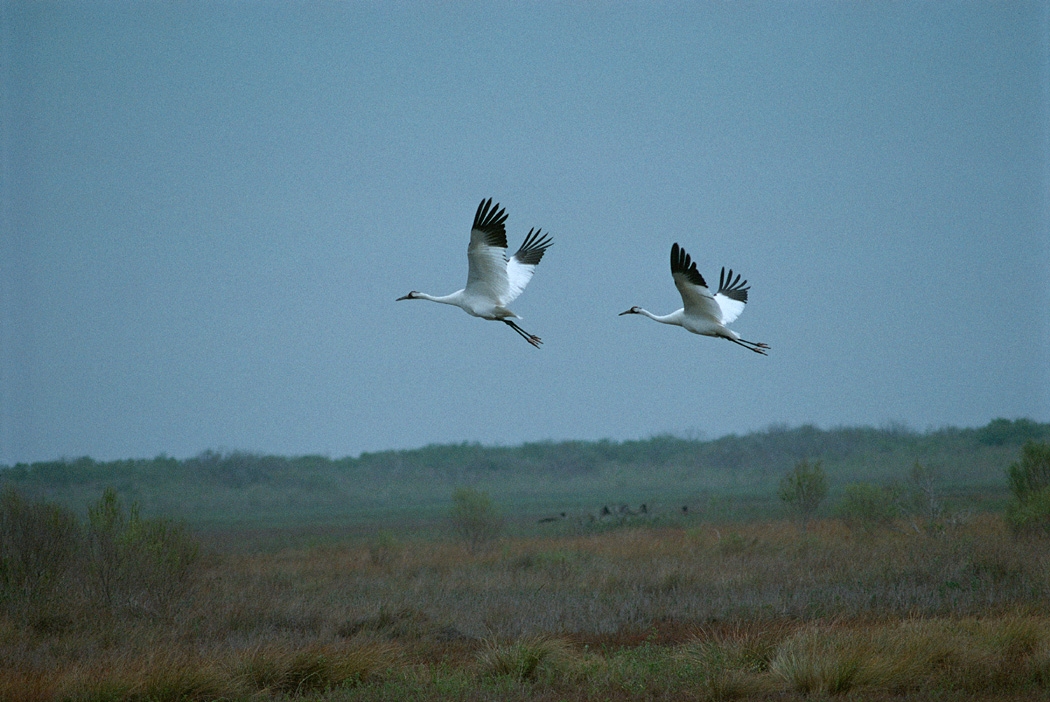
Whooping cranes in Flight
In 1941, the population of the last remaining migrating Whooping Crane flock was only 15 individuals. There had never been a lot of whooping cranes. Only an estimated 1400 in 1860, but in 1940, the species appeared to face the loss of its migrating behavior. Environmentalists and government agencies responded, and by 1999 the migrating flock had grown to about 180 birds. Their summer breeding grounds are in Canada’s Wood Buffalo National Park and their wintering grounds are at the Arkansas National Wildlife Refuge in Texas. There were also resident, non-migrating whooping cranes living in a number of sanctuaries in the U.S. and Canada.
Scientists recognized that if the entire population of migrating whooping cranes used the same wintering and breeding locations, the whole flock could easily be wiped out by human impacts, disease, or sudden changes in the weather. In the 1990s, efforts began to develop a second migrating flock. These met with failure until scientists teamed up with William Lishman, who had learned to lead Canada Geese chicks on migration routes using ultralight aircraft. For a movie inspired by Mr. Lishman’s discovery, see Fly Away Home.
Young whooping cranes, like most other birds, will “imprint” on the animals that they first see and hear after they are born. In the wild these are the chicks’ parents. Imprinting is an essential step in the development of young whooping crane chicks because they don’t know instinctively how to catch food, which food to catch, or how to fly. They have to be taught these skills by their parents.
To establish a new migrating whooping crane flock, scientists needed the birds to imprint on the sounds of ultralight aircraft and non-human, crane type costumes donned by their caretakers. When the birds are ready to fly, they will follow the ultralight aircraft on exercise runs and finally, on a migration to southern wintering grounds. The next spring, on their own, the birds will retrace their flight to the location where they hatched.
This is a complex undertaking. Wintering and summering grounds and rest stops along the journey must be secured. A source of eggs must be found. Government permissions must be obtained. Whooping cranes are too scarce to experiment using their eggs, so a closely related non-endangered species must be located to be used for the trials.
A partnership of conservation organizations and government agencies, called the Whooping Crane Eastern Partnership (WCEP), undertook the task. Ultralight aircraft would lead the birds from a new breeding ground in the Necedah National Wildlife Refuge in central Wisconsin to a new wintering ground at the Chassahowitzka National Wildlife Refuge on the west coast of Florida. At first, trial runs were attempted using Sandhill cranes, a close relative of the whooping crane which is not endangered. A migratory path with stopovers for rest and feeding was established and some of the cranes returned on their own to the hatching site the next spring. However, the cranes had lost their fear of people and would land in school yards and other places where people congregated. To maintain the wildness of a reintroduced migratory flock, human contact had to be all but eliminated.
After testing methods of insulating another group of Sandhill cranes from human contact, the WCEP tried its first migration of whooping cranes, led by Mr. Lishman and his partner in Operation Migration, Joe Duff. It was successful and efforts to increase the flock have continued each succeeding year. In 2005, the new Eastern Whooping Crane migrating flock consisted of 46 birds.
Whooping Crane Migration Routes
![nep_mapb[1]](https://teachwithmovies.org/wp-content/uploads/2019/03/nep_mapb1.jpg)
Wild migration route shown by green arrow.
Reintroduced Eastern flock migration route shown by black line.
Source: U.S. Fish and Wildlife Service.
EXAMPLES OF BIOME MIGRATION
IN ANIMALS OTHER THAN BIRDS
Examples of Invertebrate Biome Migration
Invertebrates are the largest phylum of the animal kingdom. Here are two examples of invertebrate species which migrate:
The Chinese Mitten Crab (Eriocheir sinensis), lives for 3 – 5 years in fresh water. It then migrates to brackish water and mates. Females, with their eggs attached to the outside of their shells, move to the sea. They remain offshore during the winter months. In the spring, they move closer to shore where their eggs hatch. The young crabs spend their first year in brackish water and then migrate upstream to fresh water where they grow to maturity. The Chinese Mitten Crab exists in three biomes during its migration (salt water, brackish water, and fresh water).
TEACHER COMMENT: These crabs are native to the Asian Pacific, with a home range of Korea, China, Japan and the Russian Pacific coast. Migrating through the release of bilge water from ships, in the early 20th century, they invaded Europe and later North America. The crabs have damaged local ecosystems and forced out local species in some areas. Because they burrow they have damaged embankments and clogged drainage systems. Source: Wikipedia Article on Chinese Mitten Crab.
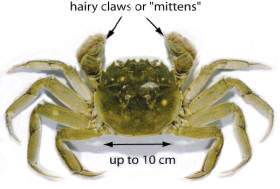
Chinese Mitten Crab
Three Biome Migrator
U.S. Geological Survey
The taxonomy of the Chinese Mitten Crab is as follows: Kingdom: Animalia; Phylum: Arthropoda (crustaceans, insects, spiders, and relatives); Class: Malacostraca (crabs, krill, pill bugs, shrimp, and relatives); Order: Decapoda (crabs, shrimp, and relatives); Suborder: Pleocyemata (Decapoda with certain characteristics of gills, legs and reproduction); Family: Grapsidae (marsh crabs, shore crabs, and talon crabs); Genus: Eriocheir (mitten crabs); Species: Eriocheir sinensis (Chinese Mitten Crab).
For the lecture, TWM’s Taxonomy for the Chinese Mitten Crab will illustrate the biological classification of this animal.
Coconut Crabs (also called Robber Crabs) are land crabs with pincers large enough to crack a coconut. They live exclusively on land except that all female crabs release their larvae into the ocean on the same night. The larvae that survive hatch into young crabs. They live either on the floor of the ocean or on the beach as hermit crabs using existing shells or pieces of coconut to protect themselves. During this period they lose the ability to breathe sea water and live as land animals for the rest of their lives.
Examples of Biome Migration in Mammals
Mammals are a class of the phylum chordatus (vertabrates). (Remember your biological classifications: Kingdom, Phylum, Class, Order, Family, Genus, and Species.)
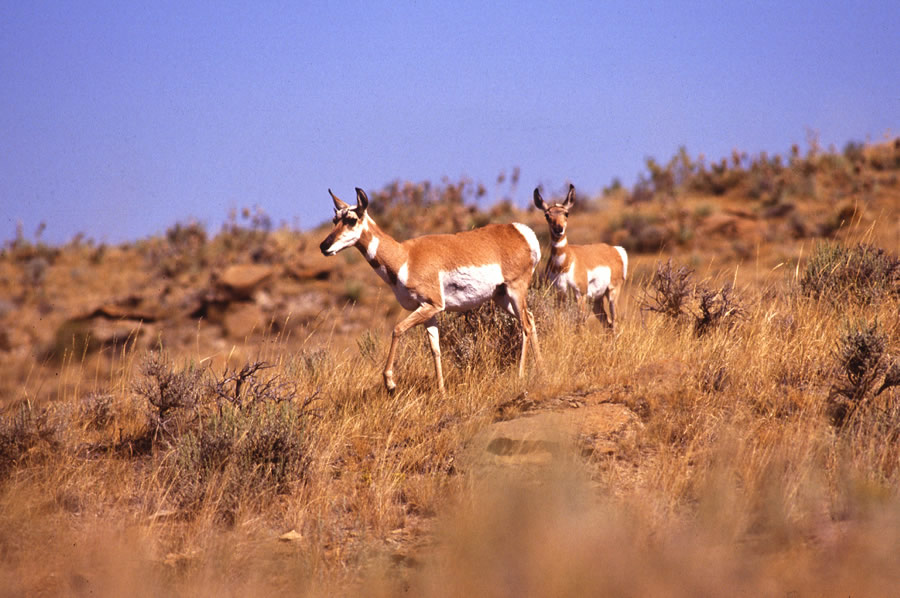
Pronghorn Antelope — only Antelope Remaining in North America;
Only Large Migrating Mammal Left in North America
Agricultural Research Service Photo Library
Antelope: Pronghorn antelope still migrate in and out of Grand Teton National Park between high mountain summer range and lowland winter range. Their route is 170 miles long, the longest terrestrial mammal migration in the Americas, and is greatly imperiled by land and energy development. In recent years, the size of the herd has plumetted from more than 400 animals to about 150 today. Pronghorns are the only surviving antelope species in the Americas. There are a few hundred thousand pronghorns scattered from Montana to Arizona, but the herd migrating from Grand Teton is the only migratory group. Efforts are being made to create safe corridors for the pronghorn to move from their summer to their winter ranges. For visuals and information, see Path of the Pronghorn Migration from the Wildlife Conservation Society and Rallying to Protect U.S. Antelope Migration Route from National Geographic.
Caribou: Relatives of the Eurasian Reindeer, caribou migrate each year from the tundra regions of northern Canada, Greenland, and Alaska to wintering grounds in the Canadian forests. Caribou have been migrating for more than 27,000 years. Some caribou herds travel more than 1900 miles (5000 km) each way. They return north in the spring. For learning materials about caribou see Project Caribou and Being Caribou.
Bats: Bats have two responses to changing weather and the seasonal nature of food supplies. Some become dormant and others migrate. The Mexican free-tail bat travels nearly 1000 miles (1600 km) between winter roosts in Mexico and summer roosts in the United States. The lesser long-nosed bats follow the “nectar corridor,” a 1,000-mile highway of cactus and agave plants which extends from Central Mexico to Arizona and New Mexico. The plants bloom at night and produce nectar in sequence from south to north. The bats migrate along with the blooms, pollinating the plants as they go. Bats can travel 100 miles in a single night. Several species of bats (the Red Bat, the Large Hoary Bat, and the Silver-haired Bat) spend their summers in the northern United States and in Canada but fly to winter quarters in Georgia, South Carolina, Florida, and probably also in the Southwest. Fruit Bats and Flying Foxes native to the tropical regions of Europe also make regular mass migrations, following the seasons for fruit ripening. Sources include: Lesser Long Nosed Bats and “Bat,” Microsoft® Encarta® Online Encyclopedia 2005
Marine Mammals: Some species of dolphins migrate but others do not. Bottlenose dolphins may migrate due to variations in water temperature, migration of food fish, and feeding habits. Source: “Bottlenose Dolphin,” Microsoft® Encarta® Online Encyclopedia 2005.
Blue Whales and Humpback Whales migrate in search of food from summer grounds at the edges of the pack ice in both the northern and southern hemispheres to the tropics or near tropics in winter. The Gray Whale, a medium sized whale, lives only in the North Pacific Ocean. Individuals of this species migrate 10,000 to 14,000 miles between summer feeding grounds in the northern Bering Sea to winter calving lagoons off the coast of northern Mexico. This is one of the longest migrations of any mammal. Source: “Blue Whale,”, “Humpback Whale”, “Gray Whale”, Microsoft® Encarta® Online Encyclopedia 2005
Some Northern Fur Seals travel each year from their summer breeding range in Alaska’s Bering Sea to southern California. Elephant Seals migrate along the American west coast some 13,000 miles, twice each year. They are the only animal known to migrate two times within the space of one year. Their annual migration totals are one of the longest migrations of any mammal.
Herds of walrus follow the broken edge of the pack ice as it moves north and south with the seasons. Some older male walruses do not migrate. Walrus migrations can cover distances as great as 1850 miles (3,000 km). Some species of seals do not migrate at all. Sources include: Elephant Seals from California State Parks and “Seal,” Microsoft® Encarta® Online Encyclopedia 2005
Monkeys: Native to India, Nepal, eastern Afghanistan, northeastern China and Indochina, Rhesus Monkeys are partly migratory, sometimes ascending the Himalayas to an altitude of about 8200 feet (2500 meters) in summer. Source: “Rhesus Monkey,” Microsoft® Encarta® Online Encyclopedia 2005
Class Discussion Note: Do people migrate? Some societies have always had a nomadic lifestyle (see discussion below). But this is not migration between biomes. In the Northeast United States and Canada, a custom has arisen whereby some retired people spend summers in the North and winters in the Southeastern United States, particularly Florida. They are referred to as “snow birds”. This is probably not true biome migration because it has nothing to do with procreation or food sources and the animals that migrate are not compelled to do so by instinct.
Note that migration and the emigration that sent so many people from Europe and other countries to the Americas are quite different. Migration is periodic and part of the life cycle. Emigration is a single move and not part of the normal life cycle of an animal.
Examples of Biome Migration by Fish
Some fish live in the sea and migrate to fresh water to spawn. Others live in fresh water but migrate to salt water to spawn. Still others live in the sea and spawn in the sea.
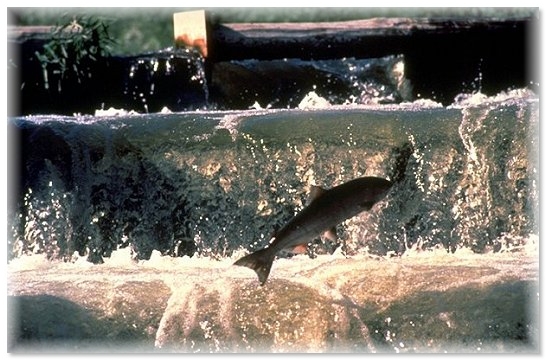
Salmon Migrating – can travel 1000 miles
upstream — U.S. Fish & Wildlife Serv.
Salmon is the most famous example of a species of salt water fish that spawns in fresh water. Salmon lay their eggs in gravel beds in lakes and streams. The young salmon take one to six years to mature before migrating to the sea. Adult salmon live in the sea for one to three years, mingling with other salmon and swimming in wide circular patterns.
To recognize the river mouth where they entered the ocean, salmon can use currents, salinity and temperature patterns, the Sun, the stars, and the Earth’s magnetic field. Scientists only know that after they reach the right river mouth, salmon use their sense of smell to reach their home stream. Some salmon travel more than 1000 miles upriver to spawn.
Salmon are found in both the Atlantic and Pacific Oceans. Atlantic Salmon live up to eight years and return to their home streams to spawn repeatedly. Pacific Salmon spawn only once and then they die. Salmon who will die after spawning turn grey and are no longer good to eat.
Some salmon live in streams and lakes and do not migrate to the sea. Fresh water salmon, like their counterparts who travel to the sea, return to the place in which they were spawned to lay their eggs. The taxonomy for Atlantic Salmon is: Kingdom: Animalia; Phylum: Chordata; Subphylum: Vertebrata; Class: Actinopterygii (Ray-fin fishes); Order: Salmoniformes; Family: Salmonidae; Species: Salmo salar. Sources include: Salmon Background Information for Teachers and “Salmon, fish” Microsoft® Encarta® Online Encyclopedia 2005
Eels migrate up to 5,200 miles (6,000 km) from the coast of Europe or North America to spawn in the Sargasso Sea. For an explanation and a good visual of the location of the Sargasso Sea, go to The Sargasso Sea. They begin their lives in warm saline Atlantic waters at depths of about 1,300 to 2,300 feet. The eggs develop into transparent leaflike larvae. Carried by the Gulf Stream to the shallow waters of the continental shelves it takes about two and one-half years for eels to attain a little more than three inches.
coastal waters as glass eels they begin to swim upstream in the spring by the millions. At that point, a metamorphosis occurs and the eels change into cylindrical, pigmented bottom-dwellers. The migration can lead to spectacular sights as when the young fish form a dense mass several miles long. Sometimes the eels pile up onto each other by the tens of thousands in order to climb obstacles. They will crawl across wet grass and tunnel through wet sand for up to 30 miles to reach upstream headwaters and ponds.
Eels live for 10 to 15 years in fresh water, eating insects, worms, and small crustaceans. At the end of their lives their bodies change again dramatically. Their eyes start to grow and develop optimal vision for the dim blue of the clear ocean water. The sides of their bodies turn silvery for camouflage during their long trip back to their spawning grounds. At this stage they are called silver eels. After the eels spawn, they die. The physical changes in eels are unusual among migrating animals.
In recent decades, the number of eels reaching North America and Europe has declined dramatically. North American eels are Kingdom: Animalia; Phylum: Chordata; Subphylum: Vertebrata; Class: Actinopterygii; Order: Anguilliformes; Suborder: Anguilloidei; Family: Anguillidae; Genus: Anguilla; Species: Anguilla rostrata Sources include Eel Story from Wikipedia.
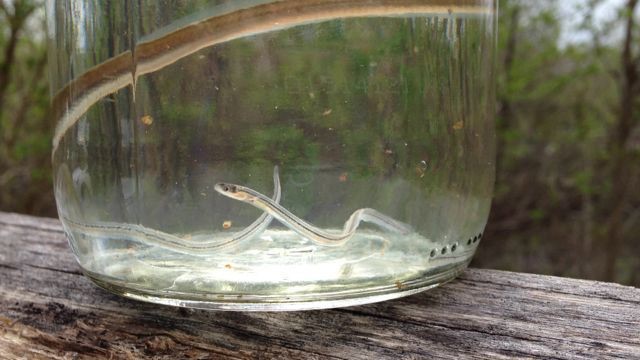
Glass Eel, U.S. Fish & Wild Life Serv.
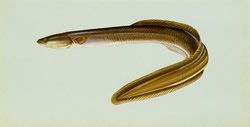
American Eel, U.S. Fish
& Wild Life Serv.
Classification of Migrating Fish
diadromous — Fish who travel between salt and fresh water normally and regularly at any point in their life cycle are diadromous. The word was derived from dia meaning “across” combined with the Greek word dromous meaning “running”). There are three types of diadromous fish: anadromous, catadromous and amphidromous.
anadromous — Diadromous fish who live primarily in the sea but who breed in fresh water are anadromous. The word was derived from the Greek ana meaning “upwards” or “backwards” combined with dromous meaning “running”. Anadromous fish swim upstream to breed. Salmon are anadromous.
catadromous — Diadromous fish who live primarily in fresh water but who breed in sea are described as catadromous. The word was derived from the Greek cata meaning “down” or “in reverse” combined with dromous meaning “running”. This reference comes from the historical fact that the first fish migrations that were observed by people were migrations from salt water to spawn in fresh water. It was only later that scientists noticed that some fish migrated the other way, from fresh water to spawn in salt water. Source: FACTS.
amphidromous — Diadromous fish who move between fresh and salt water during some part of their life cycle, but not for breeding are called amphidromous. The word was derived from amphi meaning “of both kinds” or “on both sides” combined with dromous meaning “running”.
potamodromous — Fish who migrate only within fresh water are described as potamodromous. The word was derived from pota derived from potable which means suitable for drinking combined with dromous meaning “running”);
oceanodromous — Fish who migrate within salt water only are referred to as oceanodromous. The word is derived from ocean combined with dromous meaning “running”.
Examples of Biome Migration in Insects
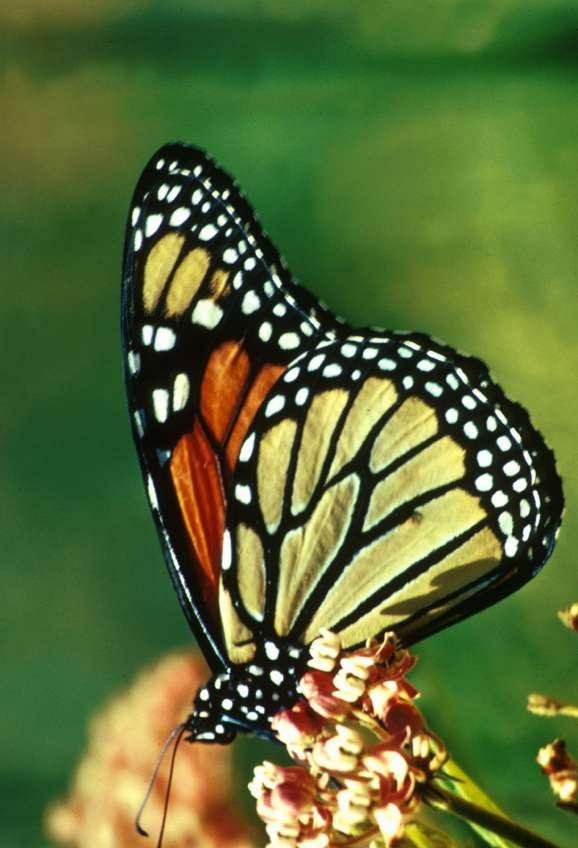
Butterflies The beautiful Monarch Butterfly is sometimes called the “milkweed butterfly” because its larvae feed only on milkweed plants. It is found primarily in North America. The larvae hatch, depending on the weather, in three to twelve days. The larvae then develop into caterpillars about two inches long. The caterpillars also feed on the milkweed and then attach themselves head down to a convenient twig. Shedding their outer skin, they transform into a pupa (or chrysalis) in about two hours. The pupa appears to be a waxy, jade vase. In about two weeks, the pupa has become transparent and the adult butterfly emerges. The wings of the newly hatched butterfly are spread when blood from the body of the butterfly is pumped into them.
The wings of a Monarch are reddish-brown with black veins and black borders containing several rows of dots. The wingspan averages 4 inches (10 cm) and the length of the butterfly is about 1 & 4/5ths inches (45 mm). The milkweed contains a substance which accumulates in the Monarch’s body and makes it distasteful to birds and other predators. They recognize the butterflies’ pattern and avoid them. Monarchs do not need camouflage. A palatable prey, the Viceroy Butterfly, mimics the markings of the monarch to warn predators away.
There are two primary groups of Monarchs, those that live east of the Rocky Mountains and those that live on the west coast of North America. Each group congregates in the same winter location, either at Pacific Grove, California, or the mountains in central Mexico. At these locations trees can be completely covered by Monarchs. These butterflies have been known to fly up to 1800 miles (2900 km) from Ontario, Canada, to Mexico.
Monarchs mate at the end of the winter season. After leaving their winter homes, they fly north and east with the females stopping along the way to lay eggs on the underside of milkweed leaves. They die shortly thereafter. The offspring pupates as a pale-green, golden-spotted chrysalis. The taxonomy for Monarch Butterflies are: Kingdom: Animalia; Phylum: Arthropoda; Class: Insecta; Order: Lepidoptera; Suborder: Macrolepidoptera; Family: Danaidae; Genus: Danaus; Species: Danaus plexippus. Sources include: “Monarch Butterly” Microsoft® Encarta® Online Encyclopedia 2005 and Kidzones Fun Facts for Kids
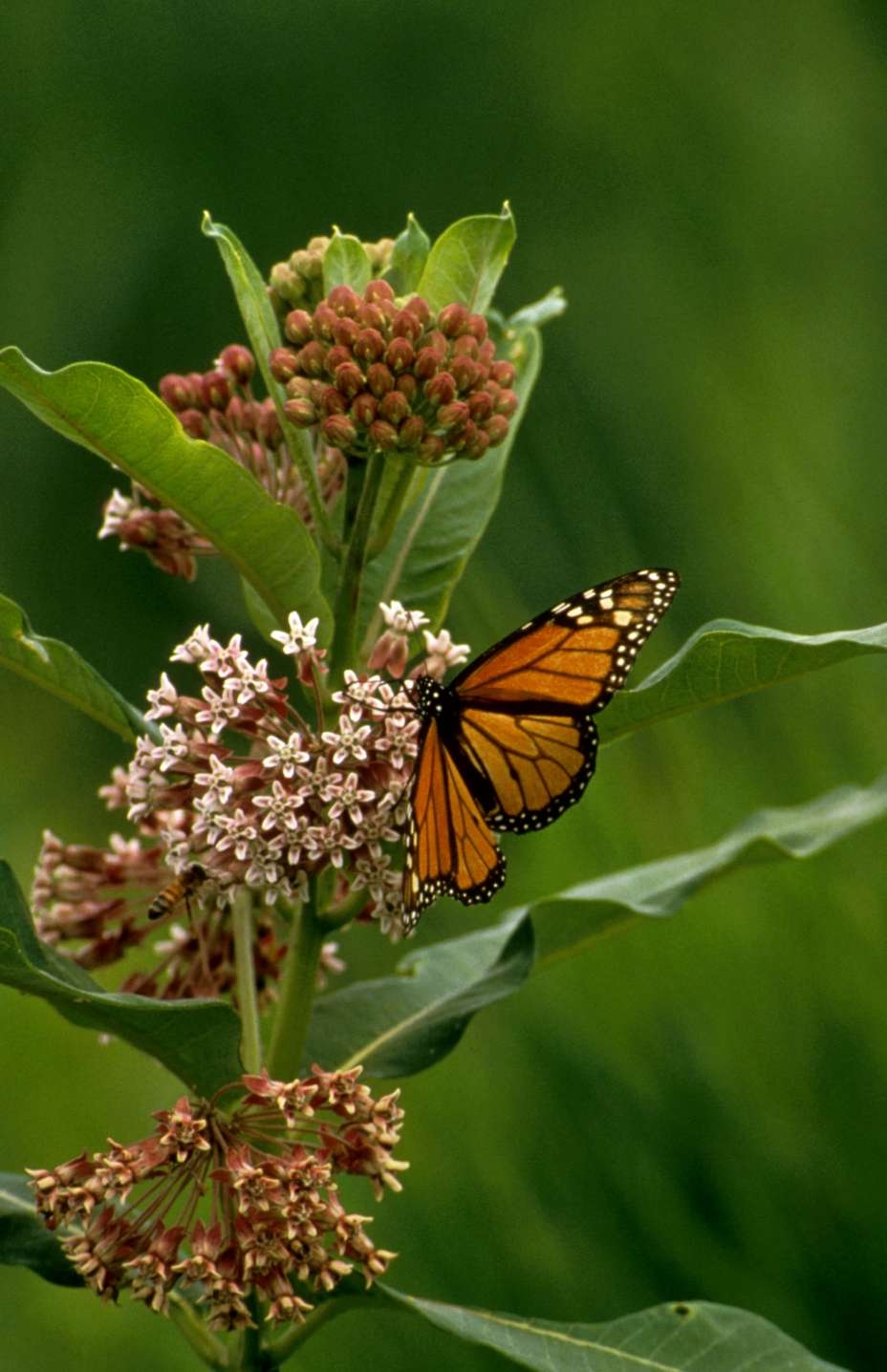
Examples of Biome Migration by Reptiles
Reptiles are their own class, equivalent to mammals, birds, insects and fish. (Kingdom: Animalia; Phylum: Chordata; Subphylum: Vertebrata; Class: Reptilia)
Most reptiles (and amphibians) are not capable of traveling great distances. When they encounter unfavorable conditions, such as lack of food or cold, they generally lapse into a state of lethargy or, if necessary, become dormant. This makes it possible for them to stay in their home range for the entire length of the year.
There are a few exceptions. Perhaps the best reptilian biome migrators are turtles. Sea Turtles have been on the Earth for 150,000,000 years. They migrate for thousands of miles in the ocean. South American river turtles travel along their home rivers in large groups. Their destinations are sandbars where they lay their eggs. Giant land tortoises, despite their great body weight and slow pace, migrate 30 miles (50 km) across rough terrain. They travel from their usual range in the upper humid zone, where food is abundant, to a dry zone in which they lay their eggs. The taxonomy for sea turtles is: Kingdom: Animalia; Phylum: Chordata; Subphylum: Vertebrata; Class: Reptilia; Order: Testudines; Family: Cheloniidae; Genus: Caretta; Species: Caretta caretta.
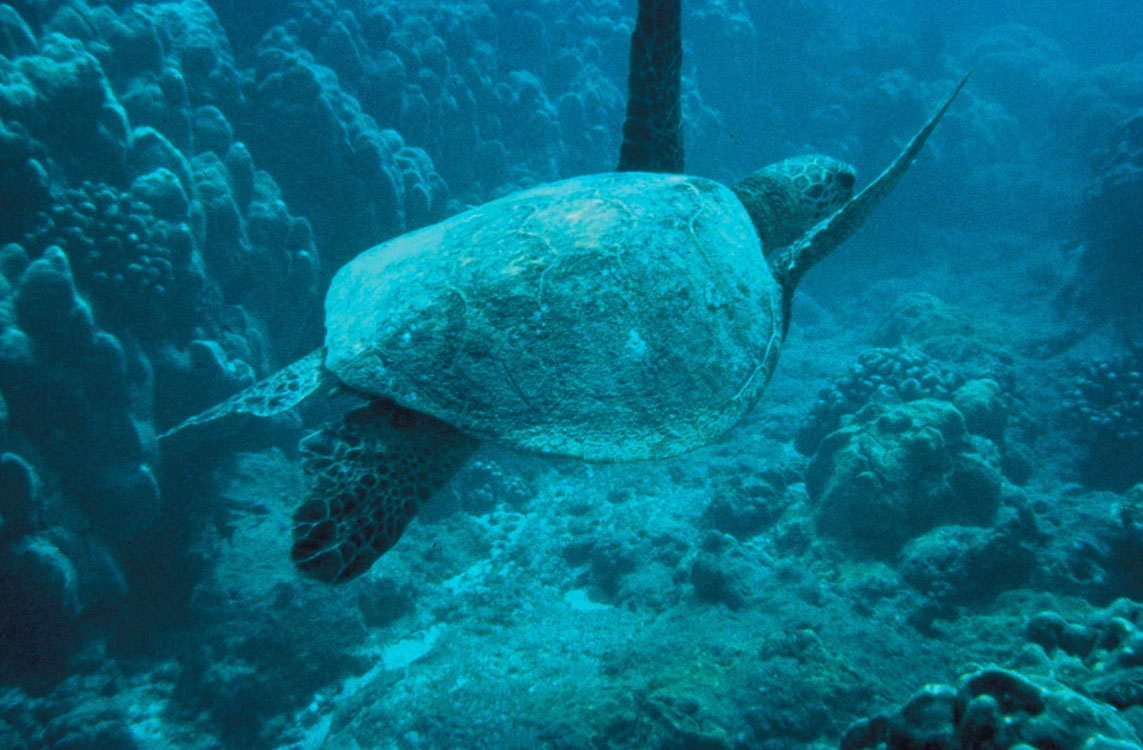
Sea Turtles Migrate Thousands of Miles; the longest reptile migration
NOMADISM – FOLLOWING FOOD AND WATER
Nomadic behavior occurs when a species follows sources of food and water, sometimes with a definable pattern and sometimes with no particular pattern. Most nomadic animals restrict themselves to one biome but, as always, there are exceptions.
Human and Some Other Animal Kingdom Nomads
Human Beings: Nomadic behavior in human societies can be grouped into three general categories: hunter/gatherer, pastoral, and tinker/trader. Many societies exhibit features of more than one of these general types.
Most hunter/gatherer societies are nomadic. Some, such as the Kalahari San, move daily. Others move less frequently. The frequency of movement depends on the abundance of game or water and the technological level of the society. Nomadic hunters and gatherers frequently organize themselves into small and isolated bands. They usually move through territory where they know the location of game, water holes, and plants. Most groups have established sites which they visit for a portion of each year.
When a society domesticates animals but the land will not support year-round grazing, families or small groups will go from place to place to find good pasture. In desert environments, these pastoral societies, gather around sources of water. Some cultures maintain domestic animals but also hunt and gather. They may also practice some agriculture, or trade with settled peoples for food or other goods.
The third type of nomads, tinkers and traders associate themselves with a larger settled society but hold to their mobile way of life. They may make and sell simple products, hunt, or hire out as laborers or, like the Roma (Gypsies), provide entertainment.
Human nomadic cultures are not always cultures of poverty. For example, the Mongol Hordes of Attila the Hun conquered much of the known world. The Mongols are also an example of a nomadic population which extended over more than one biome.
Nomadic human cultures have existed on every continent and in every age. They include: some Native American tribes, the San people of South Africa, the Sami (Lap Landers) of Arctic Europe, the Bakhtiari of Iran, the Bedouins, and the aborigines of Australia. While nomadic peoples are usually associated with pre-industrialized societies, tinker/trader nomads such as the Sammie Gypsies and the Travellers of Ireland exist in post-industrial societies. Migrant workers who follow the harvest have an element of nomadism in their lives.
While human beings are perhaps the most accomplished nomads, other organisms have adapted in ways that are accurately described as nomadic. Some birds are nomads, flying from place to place in search of food without any regular pattern. Ducks, parrakeets, and seedeaters of the arid zones of Australia follow infrequent, unpredictable rains. If they find water, they feed and breed. When the water dries up or the food is exhausted, they move to other areas. Irregular ecological conditions will result in this type of nomadism.
It’s Not Classic Migration and It’s Not Classic Nomadism — What Is It?
Migration and nomadism are imprecise categories. There are many behaviors that appear to have characteristics of both.
The “Nomadic Migration” of Large Land Mammals: Wet and dry seasons which affect the availability of food and water cause herds of large African mammals to move. Seasonal movements of herds of wildebeests, zebras and other plains animals of the Serengeti extend for more than 1,000 miles (1,1600 km). The herds spread outward during the rainy season and concentrate around water holes during the dry season. Gnus, a species of antelope, live in the plains and open woodlands of Southern and Eastern Africa. Some herds of gnus are sedentary and others move to find food and water. In southern Africa, hundreds of thousands of Springbok once followed the rainfall over a vast range. Herds of Springbok were so dense that other animals in the way were trampled if they could not move along with the herd. Losses from starvation, drowning, or disease controlled the population of the herd during these movements. Springbok herds are much reduced but still follow rainfall in Namibia and in Botswana.
Elephants eat more than 500 lbs (225 kg) of vegetation each day. Even small elephant herds quickly use up water and food in any area. Therefore they must keep traveling on an extended loop, moving seasonally within their home range. This can extend over 600 square miles (1,500 sq km). Elephant herds can travel 3,100 to 6,200 miles (5,000 to 10,000 km) in one year. This is the longest land mammal migration on record. Sources include: “Elephants,” and “Antelope,” Microsoft® Encarta® Online Encyclopedia 2005
In prehistoric times, the largest land animal in North America, the bison, spread its range across the Bering Straight land bridge from Europe to North America. Bison flourished from Alaska and western Canada across the U.S. into northern Mexico.
Moving south in the fall they would turn north after spring rains replenished the grass. Bison herds traveled in more or less circular patterns moving 200 to 400 miles (320 to 640 km) from their summer ranges. As with other large mammals, routes of bison travel were not well defined. The construction of transcontinental railroads in the mid-19th century blocked bison travel routes. Bison were slaughtered by the millions and their herds are hardly a shadow of what they once were. For more on bison, see American Bison from Animal Field Guide.
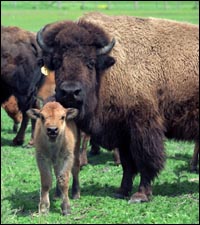
Buffalo — Fermi Lab
The Explosion of Lemmings: A number of rodent species use movement in their effort to adapt. Here is one famous example of a type of “migration” called “irruption”. Approximately every four years, overpopulation causes an overcrowding of habitat among Norway Lemmings. Thousands of animals suddenly spread out in all directions in search of food. They swim lakes and ford rivers. They eat all vegetation in their path. Those that reach the sea attempt to swim across as if it were a lake or a river. They don’t make it to the other side. Most lemmings die in these migrations, but enough survive to start the migratory cycle all over again in a few years.
The periodic explosion of lemmings is similar to other rodent “migrations” in which over population causes animals to disperse in all directions, seeking food and shelter. (By the way, rodents are mammals, i.e. warm blooded animals that suckle their young. Kingdom: Animalia; Phylum: Chordata; Subphylum: Vertebrata; Class: Mammalia; Order: Rodentia.) Source: “Lemming,” Microsoft® Encarta® Online Encyclopedia 2005; and Wikipedia article entitled “Lemming”
The Implosion of Locusts: While populations of lemming explode, moving out from an overpopulated range, the movement of large groups of locusts is usually one of implosion. Typically this happens at the end of a series of good seasons. During the good weather, locust populations expand from their home ranges into marginal areas. When the good times end and the marginal areas become inhospitable, the newly enlarged locust populations try to return to their home range. As they go, they eat everything in their path. This type of movement is called “removal migration”.
The Wanderings of Bacteria: Bacteria are single cells with no nucleus. Fossils show that bacteria were probably the first forms of life and that all other organisms evolved from them. Bacteria are the most numerous organisms. They comprise their own kingdom, on a par with Kingdom Animalia. Some bacteria are said to “migrate”.
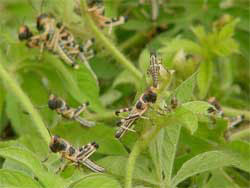
Locusts imploding; devouring a plant — USAID
Magnetotactic bacteria are aquatic swimming organisms that contain a string of magnetosomes, tiny magnetic crystals enclosed in a membrane. The magnetosomes form into chains and are fixed in the cell. The cell turns with the magnetosome chain as it aligns with the magnetic field. The figure below shows the chain of magnetosomes inside a bacterium.
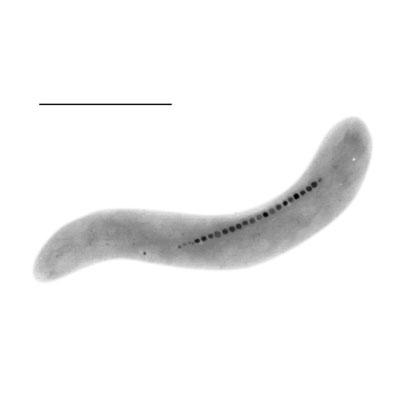
Transmission Electron Micrograph
of Magnetospirillum. Bar = 1 micron.
Water contains higher levels of oxygen closer to the surface. Therefore, bacteria that thrive in water or mud with less oxygen generally need to move away from the surface. (Bacteria that do not thrive in oxygen-rich environments are called anaerobic.) In the Northern Hemisphere, geomagnetic north actually points down at an angle. When bacteria align to this magnetic field, they too will point down. When they swim forward, they will swim down into areas with less oxygen. In the Southern Hemisphere, swimming to the geomagnetic north would lead bacteria upward toward more highly oxygenated water. For this reason anaerobic bacteria in the Southern Hemisphere have adapted by moving in the opposite direction than their brethren in the North.
Is the movement of bacteria nomadic? Not really. They’re not moving from exhausted sources of food or water to new ones. It’s an environmental issue for them, they cannot thrive in highly oxygenated water. Nor do they migrate in the sense of biome migration. There is no established route, no home range, no breeding range, no change of biome, etc. Perhaps they’re just moving and the categories of migration and nomadism don’t really apply.
Sources: Magnetic Microbes from the Digital Learning Center for Microbial Biology, Living Lodestones: Magnetotactic Bacteria by Cat Faber and Magnetotaxis in Bacteria by Richard B. Frankel, Department of Physics, Cal Poly State University, San Luis Obispo, CA and others.
In discussing bacteria, teachers might want to read to the class and discuss this interesting excerpt:
“We think of oxygen as vital to life, and it is, for us. But oxygen is also a very harsh, corrosive element, and living things have to be specially adapted to undo the harm it causes in order to be able to tolerate it for any length of time, much less to use it in metabolism. Many types of bacteria are not adapted to oxygen. Such bacteria would have been much more common when Earth was much younger, before some clever cell learned the trick of using light to rip carbon dioxide apart and eat it. Even now, when the oxygen by-product of photosynthesis has thoroughly polluted the atmosphere, many bacteria find places to hide away from it, in deep water or mud or under the soil. Such bacteria are called anaerobes.” From Living Lodestones: Magnetotactic Bacteria by Cat Faber.
DORMANCY: ADAPTATION WITHOUT MOVEMENT
Dormancy is an adaptive response that has arisen independently in many different species. While migrants and nomads change their location to thrive, animals that go dormant adapt by changing themselves and profoundly limiting their activities.
Definition:
Dormancy is a state of reduced metabolic activity used to conserve energy when food is scarce, to conserve moisture when the weather is extremely hot or dry, or to protect against environmental hazards. Like migration, dormancy allows animals to extend their range to regions in which, during certain seasons (summer, winter, dry) they could not thrive.
The length and intensity of dormancy vary among species and even within species when the organisms exist in different biomes. A variation of dormancy is employed by some bacteria and lower invertebrates that develop cysts or other protective exteriors which permit the organism to survive in hostile environments for extended periods. For these organisms, dormancy is also a way of increasing their dispersal. The cysts become like seeds for plants.
Ask the class how plants employ dormancy as an adaptive strategy. This is most commonly seen in seeds which are dormant until placed into moist ground. Annuals die back during the winter, to bloom again in the summer.
There are four general categories of dormancy in living organisms.
Hibernation:
Hibernation usually refers to the winter dormancy of both warm and cold-blooded vertebrates. Hibernation is the occasion for huge decreases in the rate of metabolism and substantial reductions in body temperature. Animals that truly hibernate tend to be small mammals, weighing less than 2 pounds (1 kg). Saving energy in the winter months is more important to small animals than to large animals. The surface area to volume ratio of small animals is greater than that of large animals. With more of their skin exposed to the cold for every gram of their body weight, small animals suffer a greater temperature loss to the air per gram of body weight than large animals. The need to create more heat per gram of body weight causes small animals have a faster metabolic rate than larger animals.
Mammal hibernators include: bats, hedgehogs, ground squirrels, hamsters, chipmunks, marmots, pygmy possums, South American marsupials called colocolos, and spiny anteaters. Hibernators usually rely on fat stored during the summer. Some rodent hibernators rely on a stored food supply. (Rodentia is an order of the class Mammalia.) Hibernators often protect themselves from cold and predators by hibernating in a den or other protected area.
Species of reptiles, amphibians and fish also hibernate.(Kingdom: Animalia; Phylum: Chordata; Subphylum: Vertebrata; Classes: Reptilia, Amphibia and Actinopterygii (Ray-fin fishes)). Certain species of lizards, snakes, turtles, frogs and toads hibernate. One species of bird, the Poorwill, hibernates.
A hibernating animal will lower its body temperature to a level just above the temperature of its environment. The body temperature of a true hibernator generally falls below 50° F (10° C). The average is about 43° F (6° C). The body temperature of a hibernating Arctic Ground Squirrel may be as low as 27° F (-3° C). When reptiles go into hibernation, they appear lifeless, with no body functions, and their temperature can drop below freezing. They can be divided into two groups: (1) those that tolerate freezing of up to 65 percent of their body water; and (2) those which produce antifreeze like compounds that permit them to stay liquid far below 0° Fahrenheit (-18° Centigrade). Here are two examples given by one naturalist:
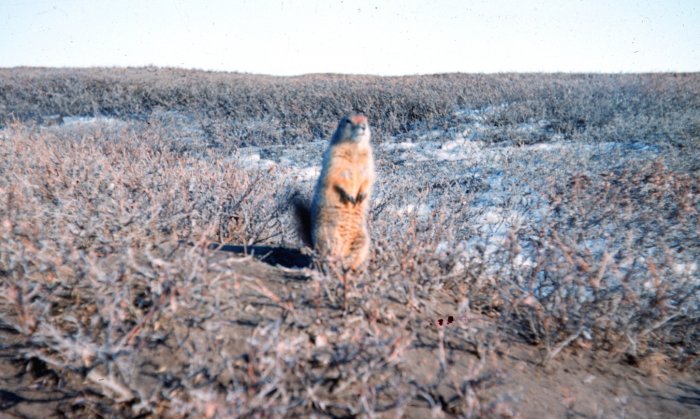
Arctic Ground Squirrel– Hibernating Temperature to 27°F (-3° C) NOAA Photograph
Wood frogs exemplify . . . freeze-tolerant animals. As the temperature drops, these frogs produce an antifreeze, which allows them to control where and when ice forms. With this control, frogs can ensure that ice does not form within their cells, which would kill them, and they can prepare their metabolism to be turned off.
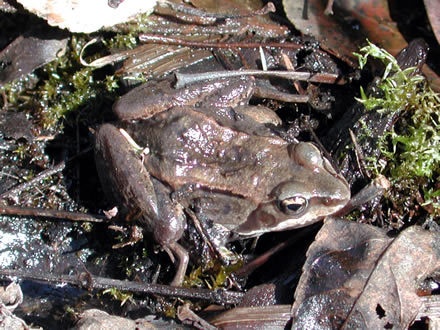
Wood Frog — It has antifreeze in its blood;
in hibernation neither breathes nor bleeds.
USGS Patuxent Wildlife Rsch. Ctr.
When frozen, a wood frog neither breathes nor bleeds, and has a barely recordable heart beat. Once temperatures climb, all functions return. The frogsicle becomes a happy hopper. Gall moth caterpillars typify the second group. They avoid freezing at all costs. Despite what most of us think, water can remain liquid down to -40° Fahrenheit (-40° Centigrade) provided it is free of impurities, so these caterpillars purify what little water they contain by emptying their guts of foreign food particles and bacteria. In addition, they produce an antifreeze, much like that used in cars but different than that used by freeze-tolerant animals, to lower the temperature at which ice forms. Combining these two methods allows gall moth caterpillars to survive winter temperatures as low as -36° Fahrenheit (-38° Centigrade). From The Deep Sleep by David Wilson.
During hibernation, heartbeat is slow and barely perceptible. Respiration drops to a few breaths per minute. (Hibernating bats may reduce their heart rates from a high of over 600 beats per minute during mid-flight to a low of under 20 beats per minute.) Animals in true hibernation will appear to be dead.
Hibernators are usually not responsive to outside stimuli. For example, the Poorwill, the only deep hibernating bird, will not be aroused even when researchers shine lights into their eyes, handle the birds, and weigh them. However, hibernators maintain careful control of their metabolic state. When their body temperature falls too low, the animal will generate heat to raise that temperature.
Typically, hibernation occurs in bouts, or episodes. Each lasts from a few days to a few weeks depending upon the body size of the animal, the outside temperature, and the time of year. Between the periods of inactivity, an animal will increase its body temperature to a normal level and become active before lapsing back into hibernation in a few hours.
Scientists are not sure what finally causes a period of hibernation to end. Some suggestions are: warmer temperatures, the need to excrete accumulated waste products, the need to replenish lost body water, or inherited seasonal rhythms. There is probably no one mechanism that applies in all species.
Torpor:
This state of short term somnolescence is usually a daily occurrence. At some point during the day, metabolism slows down and body temperature drops, although not as much as in hibernation. An animal in torpor usually doesn’t see, hear, or feel things around it. Waking up from a state of torpor takes a little time during which the animal is groggy.
Examples of animals that go into torpor are: hummingbirds, badgers, raccoons, skunks, bats, bears, chipmunks, nighthawks, hamsters (wild), and ground squirrels. Certain species of hummingbirds and frogs are in torpor at night. That is called nocturnal torpor. Diurnal torpor occurs during part of the daylight hours. Land snails, bats, and the door mouse employ diurnal torpor.
Some scientists view hibernation, torpor, and sleep as different levels of a similar phenomena that reduce awareness, lower metabolism and conserve energy. Others point to differences between sleep on the one hand and hibernation and torpor on the other. An animal which is asleep can dream. Animals hibernating or in torpor cannot dream because in those states insufficient oxygen and nourishment is given to the brain for the animal to dream.
In some species, torpor lasts more than a few hours and can extend for days or even months. An example is the winter torpor of bears which is often mischaracterized as hibernation. During its winter sleep, the body temperature of a bear is reduced only a few degrees and it will have periods of arousal during the winter in which it will get up and move around. A few bears have been known to give birth during the winter and to suckle their young. In fact, if there’s enough food around, bears will forego their winter torpor. It appears that their lethargy is simply triggered by lack of food. True hibernation is something different: a state close to death.
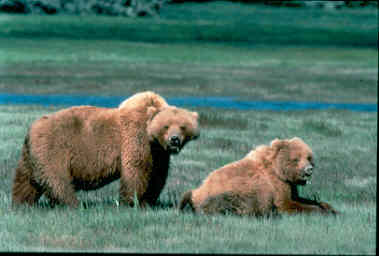
This does not mean that the change in bears during their long winter torpor is not profound. Bears do not normally urinate or defecate during their winter sleep. Water and nitrogen from urine are re-absorbed in the bladder and used as a protein which helps the bear keep its muscles healthy. Feces, hair, and nest materials form a plug at the end of the bear’s digestive tract. This is excreted when the bear awakens and leaves the den.
Estivation (also spelled aestivation):
Estivation is a period when an animal is inactive because of drought and/or extreme heat. It can occur in response to seasonal dry or hot periods or prolonged periods of drought. When some reptiles estivate they conserve 90-95% of the energy they would normally expend. Estivating animals don’t move, grow or eat. They usually find shelter in a place in which they are protected from the extremes of heat or dryness. For example, lungfish can survive years of drought by burying themselves in the mud formed at the surface of a dried up lake. Animals that use estivation include: bees, salamanders, earthworms, frogs and toads, hedgehogs, snails, snakes, mud turtles, and lizards.
Diapause:
Often classed as a type of estivation and usually occurring in a hot or dry environment, diapause is an interruption in the growth of an animal, usually an insect or a mite. Diapause is also employed by some crustaceans and snails. Diapause is particularly common among insects living in desert regions. During the summers, when the temperature is particularly hot and dry, the insects hide themselves behind protective objects such as leaves or by burying themselves in the soil. Some insect species use diapause to withstand cold and freezing temperatures during the winter.
While diapause is often programmed genetically to occur at a particular time or stage of development, it can also occur in response to environmental triggers, such as length of day, temperature, or lack of food. Diapause most often occurs among pupae (e.g., the cocoons of moths) but it may occur during any stage of life.
Some species whose range encompasses more than one biome both hibernate and estivate. Crocodiles will burrow into mud to estivate during droughts. In colder regions, they burrow into the mud to hibernate during winter.
Dormancy’s Important Impact on Human Beings: Dormancy in some invertebrate parasites and in parasitic, free-living protozoans (one-celled animals) can lead to serious disease in human beings. In response to temperature changes, hostile environments, or lack of food or water, these simple organisms will secrete a protective cyst that allows transmission to a new host. For example, the cyst stage of the oriental liver fluke, an invertebrate parasite, develops in fish muscle. Cooking will destroy the cysts, but when infested fish is eaten raw or undercooked, cysts will open in the new host and the parasite will grow there. (Kingdom: Animalia; Phylum: Platyhelminthes; Class: Trematoda; Order: Opisthorchiida; Suborder: Opisthorchiata; Family: Opisthorchiidae; Genus: Clonorchis; Species: Clonorchis sinensis.)
Trichinosis, caused by a worm (an invertebrate parasite) lives in the meat of pigs. It forms cysts. It too will die if the meat is well cooked. However, when undercooked pork is eaten, digestive juices dissolve the cyst wall. The worm then makes its way into the tissues of its new host. Single cell amoebic dysentery grows in the intestines of people. The amoeba develop cysts that enable them to survive in water. When a person is ill with amoebic dysentery, the cysts are disbursed in fecal material and unless strict sanitation is observed the cysts will infect others through the water supply.
Sources for information on Dormancy include: Encyclopedia Britannica, 2005, several articles; MSN Encarta, articles on Hibernation, Crocodiles, Painted Turtles,Dormancy in Animals from the BBC; Thinkquest Article: The Deep Sleep; To Sleep Perchance to Dream by Judy Sullivan, Fernglen Essays; Mammalian Hibernation; and The Deep Sleep by David Wilson.
Dormancy’s Important Impact on Human Beings:
Dormancy in some invertebrate parasites and in parasitic, free-living protozoans (one-celled animals) can lead to serious disease in human beings. In response to temperature changes, hostile environments, or lack of food or water, these simple organisms will secrete a protective cyst that allows transmission to a new host. For example, the cyst stage of the oriental liver fluke, an invertebrate parasite, develops in fish muscle. Cooking will destroy the cysts, but when infested fish is eaten raw or undercooked, cysts will open in the new host and the parasite will grow there. (Kingdom: Animalia; Phylum: Platyhelminthes; Class: Trematoda; Order: Opisthorchiida; Suborder: Opisthorchiata; Family: Opisthorchiidae; Genus: Clonorchis; Species: Clonorchis sinensis.)
Trichinosis, caused by a worm (an invertebrate parasite) lives in the meat of pigs. It forms cysts. It too will die if the meat is well cooked. However, when undercooked pork is eaten, digestive juices dissolve the cyst wall. The worm then makes its way into the tissues of its new host. Single cell amoebic dysentery grows in the intestines of people. The amoeba develop cysts that enable them to survive in water. When a person is ill with amoebic dysentery, the cysts are disbursed in fecal material and unless strict sanitation is observed the cysts will infect others through the water supply.
Sources for information on Dormancy include: Encyclopedia Britannica, 2005, several articles; MSN Encarta, articles on Hibernation, Crocodiles, Painted Turtles,Dormancy in Animals from the BBC; Thinkquest Article: The Deep Sleep; To Sleep Perchance to Dream by Judy Sullivan, Fernglen Essays; Mammalian Hibernation; and The Deep Sleep by David Wilson.
I am raw html block.
Click edit button to change this html
MIGRATION, NOMADISM, DORMANCY, AND THE ABSENCE OF
THESE ADAPTIVE RESPONSES COMPARED
Stress, Opportunity, and Location in Evolutionary Responses
Animals can journey to take advantage of opportunities afforded in other biomes (migration), move to those places in the home range where they can thrive (nomadism), or adapt to environmental stresses by internal changes which preserve energy or moisture without any change of location (dormancy). In addition, non-dormant resident populations thrive without availing themselves of migration, nomadism or dormancy. There are thus three types of movement of species. Movement between biomes, movement within a single biome, and no movement.
Dormancy is properly called the inverse of migration. Migration involves travel from one biome to another while dormancy involves no travel. Migration requires the expenditure of energy in travel for the benefit of increased food resources in the destination area, while dormancy is an effort to save what little energy or moisture the organism has while remaining in its home range. Migration puts the individual animal at risk to predators and storms as it migrates, while dormancy is usually about protection of the animal and avoiding risk. Migration usually involves a relatively small internal change by the organism, most often laying on fat to provide energy for the journey. Dormancy always involves drastic changes in the metabolism of the animal; often there are physical changes as well. Dormancy is also the inverse of nomadism and a similar comparison can be made.
Help students visualize the four adaptations in terms of movement: Four Types of Adaptation in Terms of Movement
NOTES ON THE LANGUAGE OF SCIENCE
Describe Phenomena in Meaningful Ways
Migration, nomadism, and dormancy are relatively imprecise descriptions of natural phenomena. They do not precisely follow the way that nature is in fact organized. This is demonstrated by the exceptions to the rules; by the species which do not fit into any precise category. As we have seen, there are migrants, such as eels, which drastically change their physical characteristics to aid their migration. Physical changes of this magnitude are adaptations that usually occur in dormancy. Large land mammals seem to straddle the categories of nomadism and migration. Some rodents “migrate” in explosions that relieve population pressure in the home range and which cause the death of most of the species. On the other hand, locust populations implode in lean years, seeking to return to their home range. Then there are those organisms that use dormancy as an inherent part of reproduction, employing cysts or using other protective coatings to protect against hostile environments and to spread to new hosts. These are neither classically migratory, classically dormant or classically nomadic adaptations.
At times, science has been able to develop classifications that follow nature’s pattern much more closely. An example is the description of molecules in chemistry. The hypothesis that H2O is an accurate description of a water molecule at a certain level of abstraction is part of a general theory of determining the identity and quantity of atoms that make up molecules. This theory is internally consistent, has survived innumerable tests, and is helpful in problem solving. It has now been accepted as so reliable a formulation, that it is relied upon as a matter of course. Perhaps, some day, biologists may approach this level of precision in the description of how and why animals travel or don’t travel in their adaptation to their environment.
The terms “migratory”, “nomadic”, and “dormant” are still useful. They help us organize the world around us into something we can understand. They lead us to new avenues of inquiry and to new discoveries. For example, the understanding that migration in many species is an effort to reach the locations that provide the maximum food supply in the summer breeding season provides a hypothesis by which we can evaluate the reasons behind similar behavior in other species. The knowledge that bears, during their winter torpor, do not urinate but convert their urine into a chemical that is beneficial to muscles, gives us an idea, a hypothesis, to test on other animals.
Scientific Terms and Other Words Used in this Handout
See Vocabulary Exercise for Lesson Plan on Migration, Nomadism and Dormancy
Bird Population terms
Bird populations, and those of any other animal, can be described as “resident”, “migratory” or “nomadic”. A resident population stays in its home range, neither migrating nor wandering. A migratory population moves from one biome to another, usually seasonally. A nomadic population follows water or food sources, usually within one biome.
For any particular geographic area birds can be classified into four groups: “residents” — non-migrating birds such as House Sparrows who live in the area year-round; “summer residents” — migratory birds who arrive in the spring, nest in summer, and go south in the fall; “winter residents” — migratory birds who arrive in the fall, stay the winter, and leave in the spring; and “transients” — migratory species who stop on the way to somewhere else.
Definitions of words used in this Handout
anaerobic — living, active, occurring, or existing in the absence of free oxygen; or adverse to oxygen.
biome — the largest geographic biotic unit, a major community of plants and animals with similar life forms and environmental conditions. It includes various communities and developmental stages of communities and is named for the dominant type of vegetation, such as grassland or coniferous forest; also called a major life zone.
brackish — somewhat salty; not as salty as sea water; brackish water usually occurs in the locations where fresh water meets sea water.
breeding — to produce offspring by hatching or gestation.
diapause — a type of estivation and usually occurring in a hot or dry environment.
diurnal — active during the day.
dormant — in or as if in a deep sleep; inactive. The word is derived from the Latin word “dormire”, meaning “to sleep”. It is akin to the Sanskrit word that means “he sleeps”.
estivation or aestivation — Estivation is a period when an animal is inactive because of drought and/or extreme heat. The word comes from the Latin word “aestas”, meaning summer, which is when most estivation occurs.
headwind — a wind blowing from directly in front.
hibernate — the long winter dormancy of warm and cold blooded vertebrates in which metabolism is drastically reduced and body temperature lowered to near the level of the environment. It is derived from the Latin “hibernatus”, “to pass the winter”, which was itself a derivative of “hibernus” meaning “of winter”. That in turn was derived from yet another Latin word “hiems”, meaning “winter”, which itself was akin to the Greek word for winter.
implode — to suddenly collapse inward.
intraspecific — occurring within a species or involving members of one species.
inverse — reversed in position, order, direction or tendency; turned upside down.
metamorphosis — a transfiguration: a striking change in appearance, character, or circumstances.
nocturnal — active at night.
nomad — a member of a people who have no fixed residence but move from place to place usually seasonally and within a well-defined territory.
nomadism — the way of life of a group of animals who do not live continually in the same place but move cyclically or periodically.
oxygenate — to impregnate, combine, or supply with oxygen. Blood becomes oxygenated in the lungs or gills of animals.
range — the region throughout which a species naturally lives.
species — a category of biological classification ranking immediately below the genus or subgenus, comprising related organisms or populations potentially capable of interbreeding.
tailwind — a wind blowing from behind.
taxonomy — the classification of organisms to show relationships between them.
torpor — a state of motor and mental inactivity with a partial suspension of sensibility which usually lasts a few hours and is accompanied by a mild reduction in metabolism and body temperature. The word comes from the Latin “torpere”, which means “to be stiff or numb”.
vertebrate — a member of the Kingdom Animalia which has a spinal chord (Phylum Chordata) encased in vertebrae. This includes the mammals, birds, reptiles, amphibians, and fishes.
Sources: Encyclopedia Britannica, 2005; Merriam Webster Dictionary (on Britannica); Wikipedia, Random House Webster’s College Dictionary, 1999, and Bartleby.com
AN EXAMPLE OF GOVERNMENT IN ACTION: HOW THE ENVIRONMENTAL IMPACT STATEMENT PROCESS WORKS
The effort to reestablish an eastern migratory whooping crane flock requires the cooperation of the U.S. government. The northern and southern ends of the migration route are in national wildlife refuges and the birds require protection en route. In January 2001 President Clinton issued Executive Order 13186, Responsibilities of Federal Agencies To Protect Migratory Birds. This directed federal agencies to develop memoranda of understandings as to how their agencies would take steps to protect migratory birds. Federal agencies charged with conservation had already been attempting to halt the decline of the whooping crane by attempting to reestablish migrating flocks and by developing breeding programs for non-migrating populations. The effort to reestablish migrating flocks were not successful, but the breeding programs were.
The National Environmental Policy Act (NEPA) requires that before the federal government takes any action that could adversely affect the environment, it must determine what the likely environmental impact of its actions will be. The law requires that the government make a finding that there will be no significant environmental impact, or that it describe that impact in a document called an Environmental Impact Statement (EIS). An EIS is a full disclosure document that details the process through which a government project was developed, includes consideration of a range of reasonable alternatives, analyzes the potential impacts resulting from the alternatives, and demonstrates compliance with other applicable environmental laws and executive orders. Environmental Impact Statements are often time consuming and costly.
In the case of the reintroduction of a new whooping crane migratory flock, the government determined that there was no significant environmental impact and was able to pursue the project without the necessity of a full scale EIS.
The documents set out below record the process by which this was done. Because this was not a controversial project, it went with lightning speed for government projects.
- FINAL ENVIRONMENTAL ASSESSMENT — PROPOSED REINTRODUCTION OF A MIGRATORY FLOCK OF WHOOPING CRANES IN THE EASTERN UNITED STATES by the U.S. Fish and Wildlife Service; June 2001
- Finding of No Signigicant Impact; Environmental Assessment for proposed reintroduction of a migratory flock of whooping cranes in the eastern United States by the U.S. Fish and Wildlife Service, June 18, 2001;
- Establishment of a Nonessential Experimental Population of Whooping Cranes in the Eastern United States – Final Rule Published in the Code of Federal Regulations; June 26, 2001.
LECTURE NOTES — DISCUSSION QUESTIONS
One way to organize class discussion for this unit is to show 30 – 45 minutes of Winged Migration and assign, as homework, the Migration Student Handout. The lecture is constructed by asking the class the discussion questions set out below. Points to be covered in the discussion and references to audio visual aids, provided by TWM or available from the Internet, are set out in green italics after the question. Many of these discussion questions or variants of them will be repeated in the comprehension tests. For a version of these notes in Microsoft® Word®, click here.
1. What do we mean by “migration”?
The periodic movement of part or all of an animal species between biomes to gain access to better food in nesting season and safer nests.
2. What are some other meanings of the word migration?
— migration of anaerobic bacteria away from highly oxygenated water;
— nonrandom movement of an atom or radical from one place to another within a molecule.
Teacher comment: In the Northeast United States and Canada, a custom has arisen whereby some retired people spend summers in the North and winters in the Southeastern United States, particularly Florida. They are referred to as “snow birds”. This is probably not true biome migration because it has nothing to do with procreation or food sources and the animals that migrate are not compelled to do so by instinct.
3. What advantage do birds gain by migrating to the Arctic for the summer breeding season?
(1) They take advantage of explosion of food in the summer in the north.
(2) They fly back to the south in winter when food in the south is best.
(3) There are fewer predators in north during the breeding season; their young are safer in the nests.
4. In the summer, Emperor penguins live and feed in Antarctic ocean waters. In the Antarctic fall, March and April, they go onto the pack ice to pair up and to breed. The mother lays the egg which the father (still at the breeding ground on the pack ice) incubates in a special insulated pouch. This takes most of the Arctic winter. Penguins eat fish and other animals found in the ocean. There is no food for them on the pack ice. After the mother lays the egg, she returns to the ocean to feed. When the egg hatches, the mother travels back over the pack ice to feed the chick with food regurgitated from her stomach. By that time the father will have been without food for about four months. The mother then takes responsibility for the chick while the starving father returns to the sea. He comes back to the breeding ground with a stomach full of food for the chick. The parents then take turns going back and forth from the breeding ground on the pack ice to the ocean, bringing food for the chick. This continues until the summer (December or January) when the chick is old enough to fend for itself. Certainly, the ocean and the pack ice are different biomes. Do Emperor penguins engage in classic biome migration?
No. Emperor penguins do not breed and hatch their eggs during the spring and summer in which they take advantage of the food provided by the explosion of life that occurs when temperatures warm. They reproduce in the fall and winter in some of the harshest conditions on Earth. See March of the Penguins.
5. What does the Sun have to do with migration?
Seasonal change causes migration
Seasons caused by tilt of Earth’s axis —> rays more direct in summer than in winter, stronger.
6. Name two physical features of birds that allow them to fly.
There are three:
Feathers allow birds to control the flow of air over their bodies.
Hollow bones make birds light.
Magnetic crystals, probably in their brains, act like a compass.
7. What is taxonomy and what is its purpose?
the classification of organisms to show relationships between them.
8. What is the taxonomy for birds?
They are a class — Kingdom: Animalia —> Phylum: Cordata —> Subphylum: Vertebrata —> Class: Aves (birds) —>; below them are orders, families, genera, and species. Diagram: Taxonomy for the Class Aves (Birds).
Summarize the taxonomy of birds: They are animals who have spinal columns located within vertebrae, have feathers, and hollow bones and who fly.
9. What is the taxonomy for the Ruby-throated Hummingbird?
It is:
Kingdom: Animalia —> Phylum: Cordata —> Subphylum: Vertebrata —> Class: Aves (birds) —> Order: Apodiformes (hummingbirds and swifts) —> Family: Trochilidae (hummingbirds) —> Genus: Archilocus (ruby-throated hummingbirds) —> Species: Archilocus Colubris (Ruby-throated Hummingbird) — use also TWM’s taxonomy for the Ruby-throated Hummingbird
10. Name two things that every traveler needs in order to find a destination and describe their purpose.
A map to show the traveler where to go and a compass to indicate the direction of travel. When traveling thousands of miles, the calculation of route is complicated. Birds can do it.
11. Describe four of the sources of information that birds use to navigate.
There are at least five: (1) the Sun, (2) the stars, (3) the Earth’s magnetic field; (4) smell; and (5) landmarks and topographical features.
Use Migration Navigation Chart to help class visualize the answer.
12. How can migration of animals be a threat to human health? Give an example.
Avian flu has infected migrating flocks of birds and they are spreading it across the globe. Check the latest news stories about this before the lecture. See also discussion of Avian Flu in Annotated version of the student handout.
13. Describe how ultralight aircraft can be used to reestablish migration patterns in bird populations?
Baby birds imprint on planes and costumed people. They then follow the planes on a migration route. One migration north to south is all it usually takes. It is a complicated process to find a suitable ultimate destination and sage rest stops along the way.
TEACHER COMMENT: Tell the story of Ninja, the cat, who returned to his home in Washington state in 1996; family moved to Utah, 850 mile journey;
a cat named Sooty found his way back to his old home in England after being moved more than 100 miles away. Sources: Homing Instinct from PBS.
14. Do people have an ethical obligation to restore lost migratory flocks of birds? What is that obligation?
In the discussion, try to get the students to reflect on what they personally believe about the obligation to protect nature. It might be from an obligation to “nature” or to God or to mankind (to preserve the environment for future generations).
15. Describe how a residential flock of birds can evolve into a migratory flock.
This example is based on a resident population living in the northern hemisphere. Due to intraspecies competition for food, a part of the resident population begins to expand the range; if it finds abundant food at the northern terminus of the range, some of the population will have an advantage over those birds that do not move north. When they are far enough north so that the food supply dwindles in the winter, of the birds that moved north, those that go back to the home range in the winter, will enjoy better food there than those that stay in the new northern range. As the centuries pass, the continents may start to drift or the birds in the northern range simply go further and further north finding more food and better nesting grounds as they go.
16. Have a student draw a schematic of how the range would change in the evolution of a migratory flock of birds. You can also use TWM’s Diagram: Model of the Evolution of Migratory Behavior in Birds.
17. How do the migratory and residential flocks become different species?
If the migratory flock and the residential flock become separated geographically then, eventually, they will develop into separate species. This is happening with Common Yellowthroat. Birds that breed in the most southern part of the species’ range in Florida are largely non-migratory, whereas populations that breed as far north as Newfoundland migrate to the West Indies in the winter, well removed from the resident population in Florida.
Other examples, the bonobos/chimps (divided by the Congo River) and squirrels divided by the Grand Canyon. When populations are separated, mutations occur over time and eventually different species evolve.
18. Define the term “flyway” and describe the major flyways in North America.
route used regularly by many species of migrating flying animals such as birds, bats, or butterflies. — like rivers with tributaries
4 in North America: the Atlantic Flyway, the Mississippi Flyway, the Central Flyway and the Pacific Flyway.
have a student trace the flyways. For visual of the North American Flyways, see Migration Flyways.
A visual of the Asian-Australasian Flyway can be downloaded from the website of the Australasian Waders Study Group.
19. Show students a map of the world and ask for volunteers to give two examples of funnels and to describe the geographic features that create them.
Vera Cruz, Dardanelles/Bosphorus, Strait of Gibraltar, and Falsterbo.
20. Who can tell me the story of the Hawaiian Goose?
Canada Geese blown off course stranded in Hawaii — don’t migrate – have now started to lose webbing on feet, in a few million years will be a different species —
Note that other birds flew over Hawaii, stopped their migration at that point, and now use it as their winter home. In the summer, go back to their breeding ground in the north. Examples are: The Northern Shoveler, Lesser Golden Plover or Kolea, Sanderling or Huma-Kai and the Northern Pintail
21. How does the “V” or squadron formation help birds to migrate?
take advantage of the vortex generated by the flapping wings of the bird in front
saves energy
allows to see each other without its progress being impeded.
TEACHER COMMENT: The U.S. Air Force in experiments with F-18 fighters has shown that there is a 20% reduction in fuel consumption when one plane flies within the vortex caused by the wing tip of another plane. See AFF: Autonomous Formation Flight is surpassing project’s goals for a website and a picture. Sources for information on the V formation include Natural Entrepreneur and Operation Migration – Our Story
22. What physiological changes usually occur in birds before they start their annual migrations?
The birds gain weight, storing energy for the flight.
23. What is the most interesting migration that you have read or heard about? [Ask this question of a few students. Below are some possible examples from the materials].
There are many possibilities — here are a few (all but the first two are on the comprehension test)
Arctic Tern — 22,000 miles a year
Elephant Seal – two round trips a year
Chinese Mitten Crabs migrate between three biomes. — Freshwater, brackish water, and salt water.
Segue from this example to “Who can tell me the taxonomy of the Chinese Mitten Crab?” — use TWM’s Chart of the Taxonomy of the Chinese Mitten Crab
Chinese Mitten Crabs
native to the Asian Pacific
home range of Korea, China, Japan and the Russian Pacific coast.
expanded through the release of bilge water from ships, in the early 20th century
invaded Europe and later North America.
damages local ecosystems, competed with local species — burrows into embankments and clogs drainage systems. Source: Wikipedia Article on Chinese Mitten Crab.
Pronghorn Antelope — Only antelope — only large land mammal to continue to migrate in the lower 48 states of the U.S.
Caribou – migrating for more than 27,000 years between summer range in the tundra and winter range in the northern forests. Some caribou herds travel more than 1900 miles (5000 km) each way.
European and North American Eels — metamorphosis — unusual in migration
Sargasso Sea, (map at The Sargasso Sea – scroll down a bit
eel eggs develop into transparent leaflike larvae.
the then turn into glass eels — photo in materials — and begin to swim upstream in rivers.
in the fresh water a metamorphosis occurs and the eels change into cylindrical, pigmented, bottom-dwellers (photo in materials)
live for 10 to 15 years in freshwater eating insects, worms and small crustaceans.
end of life, bodies change dramatically — eyes start to grow and develop optimal vision for dim blue of the clear ocean water. The sides of their bodies turn silvery for camouflage during their long trip back to their spawning grounds. At this stage they are called silver eels.
biomes inhabited by eels are salt water, fresh water, and brackish water.
eels migrate out of the water — crawl across wet grass and tunnel through wet sand for up to 30 miles to reach upstream headwaters and ponds
Gray whales live only in the North Pacific Ocean. They migrate 10,000 to 14,000 miles between summer feeding grounds in the northern Bering Sea to winter calving lagoons off the coast of northern Mexico.
Monarch butterflies fly up to 1800 (2900 km) miles from Ontario, Canada, to Mexico.
Sea turtles migrate swimming thousands of miles — longest reptile migration
24. What are the three types of human nomadism?
hunter/gatherer, pastoral, and tinker/trader — ask the person who lists to describe each one
25. Differences between biome migration and nomadism.
migration: Change of biome vs. nomadism: usually one biome
migration: from one location to another vs. nomadism: many changes of location
migration: movement by season vs. nomadism: move when exhaust food or water
migration: opportunistic — looking for extra sources vs. nomadism: flees scarcity
for visual learners show them TWM chart on Migration
26. What does inverse mean?
“reversed in order, nature or effect.”
mathematics: -2 is the additive inverse of 2, because their sum is zero. 1/4 is the multiplicative inverse of 4, because their product is 1.
27. How is inverse different than “opposite”?
Inverse — reversed only in some ways
opposite is something “completely” different.
Most things are inverse; very few are opposite.
28. What is the inverse of migration? What are similarities and differences between them?
dormancy — no travel between biomes for better food — dormant organisms remain in their home range — minimize energy use or loss of moisture.
similarities: adaptive behavior — allows animals to exist in areas in which they would not thrive during certain seasons.
29. Name a nomadic non-human organism.
birds in Australia – large land mammals (probably – but like migratory in that their movements go with seasons; like nomadic in that they are in the same general area)
30. Compare movement of lemmings and locusts.
inverse — lemmings explode away from overpopulation, locusts implode back to home range from expansion in good years
31. What are the similarities and differences of the movements of locusts on the one hand and antelope, zebras and wildebeests on the plains of Africa on the other?
similarities: both extend range in good times and contract to home range (water holes) in bad; both implode when conditions become adverse;
differences: locusts is not annual, plains animals move each year;
TEACHER COMMENT: Actions of large African plains mammals and lemmings actions are inverse.
32. Name the different types of dormancy and briefly describe them.
(1) hibernation
in cold or warm-blooded vertebrates
body temperature drops to near the temperature outside
metabolism slows down dramatically
a state close to death
most frequently in smaller animals
(2) torpor
body temperature and metabolism drop but not as much as in hibernation;
animal does not react to many stimuli
usually lasts less than a day (but bears are an exception)
(3) estivation — a summer type of hibernation used to conserve water
(4) diapause — used mostly by insect pupae in which the development of the animal stops for a period of time
33. How can dormancy lead to the spread of disease among humans? Give an example.
trichinosis and amoebic dysentery – describe how cysts are transmitted
Note that mold uses a similar technique with its spores.
34. How do plants use a tactic that is like dormancy?
seeds that start to grow when in the presence of moist soil.
35. Why aren’t bears true hibernators?
No big temperature drops; rouse every few days; some give birth and suckle young
36. Does an animal in true hibernation or torpor react to stimuli from the environment?
No. They don’t react – wood frog, bats, hummingbirds
37. What is the relationship between hibernation, torpor and sleep?
Torpor is not as extreme as hibernation but more extreme than sleep.
Some scientists view hibernation, torpor and sleep as different levels of a similar states that reduce awareness, slow metabolism and conserve energy.
Others say sleep different. No dreaming in hibernation or torpor (not enough oxygen for brain — brain still monitors temp etc.)
38. Describe how and why magnetotactic bacteria move.
anaerobic — oxygen corrosive (free radicals, fire)
magnetosomes, geomagnetic north –> down, in southern hemisphere move opposite way
not really nomadic, not really migratory – just movement
Consider reading to the class or discussing the substance of this interesting excerpt:
“We think of oxygen as vital to life, and it is, for us. But oxygen is also a very harsh, corrosive element, and living things have to be specially adapted to undo the harm it causes in order to be able to tolerate it for any length of time, much less to use it in metabolism. Many types of bacteria are not adapted to oxygen. Such bacteria would have been much more common when Earth was much younger, before some clever cell learned the trick of using light to rip carbon dioxide apart and eat it. Even now, when the oxygen by-product of photosynthesis has thoroughly polluted the atmosphere, many bacteria find places to hide away from it, in deep water or mud or under the soil. Such bacteria are called anaerobes.” From Living Lodestones: Magnetotactic Bacteria by Cat Faber.
39. Are migration, nomadism and dormancy precise terms compared to other terms used in science?
not precise
does not follow pattern set by nature
compares poorly to description of atoms in molecules
40. There is a fourth possibility — other than biome migration, nomadism, dormancy. What is it?
residency — compare using TWM’s Comparison Diagram.
41. How do these classifications help scientists?
help form hypotheses about similar phenomena when they are observed.
LINKS TO THE INTERNET:
- Operation Migration Home Page; this site contains videos of whooping cranes and the process of training the birds to fly on the migration routes and a field journal with vocalizations from Sandhill and Whooping cranes and much more;
- Webpage from the movie “Winged Migration” containing a beautiful interactive map showing the migration patterns for thirteen different bird species and information about them; this site also provides other interesting information about bird migration;
- Migration of Birds from the U.S. Geological Service;
- Hawk Migration Association of North America;
- The Miracle of Winged Migration from “The Why Files”;
- Monarch Watch;
- ENature, the website of the National Wildlife Federation, is full of information about animals; they have a zip guide which will show the animals who live in your area;
- Migratory Bird Center of the Smithsonian National Zoological Park;
- The Whooping Crane Conservation Association;
- Whooping Crane Eastern Partnership;
- Encarta Article on Animal Migration;
- Wikipedia Article on Bird Migration;
- Bird Migration from Ornithology.com;
- Backyard Nature;
- Monarchwatch;
- All About Migration of Birds;
- Bird Navigation;
- Bird Navigation Techniques from Oregon Bird Choices;
- Animal Diversity Web from the University of Michigan School of Zoology. This is the best site we have found for determining the classification of animals.
OTHER LESSON PLANS
The Journey North states that it:
… [E]ngages students in a global study of wildlife migration and seasonal change. K-12 students share their own field observations with classmates across North America. They track the coming of spring through the migration patterns of monarch butterflies, bald eagles, robins, hummingbirds, Whooping cranes — and other birds and mammals, the budding of plants, changing sunlight and other natural events. Find standards-based lesson plans, activities and information to help students make local observations and fit them into a global context. Widely considered a best-practices model for education, Journey North is the nation’s premiere “citizen science” project for children. The general public is also welcome to participate.”
The site also contains many aids to teachers that will be helpful even if the entire Journey North curriculum is not employed.
Monarch Migration is pitched to elementary school students and contains information and activities concerning monarch butterflies and their migration.
Ornithology.com provides links to teacher resources.
PROJECTS
There are a myriad of projects that students can be given to focus their minds on migration, nomadism and dormancy. Students can be requested to research and report on: (1) the current status of the Whooping Crane Eastern Migratory Flock from Operation Migration or other sources; (2) the migratory paths of certain bird species; (3) the various funnels for migration; (4) an endangered species. Students can be asked to create poster boards illustrating any of the following (this is just a list of examples): the stages in the evolution of a migratory flock (from the information provided in Evolution of Migration or other sources; the stages in creating a migratory flock using ultralights; maps of the various flyways or the migration route of a particular species; the changes that a particular animal goes through when going dormant, the differences between the winter torpor of bears and true hibernation, etc.
TWO COMPREHENSION TESTS
Test on Biome Migration Among Birds
This is a 20 point test. Six of the more complex questions count for two points. It stresses the concepts described in the Migration Student Handout and the teacher notes in the annotated version. There are also a few simple factual questions. For an answer key to this test, click here. For a version of the test in Microsoft® Word® click here.
1. What advantage do birds gain by migrating to the Arctic for the summer breeding season? The answer to this question will count for two points.
2. What does the Sun have to do with migration? The answer to this question will count for two points.
3. Name two physical features of birds that allow them to fly.
4. Name two things that every traveler needs in order to find a destination and describe their purpose.
5. How can migration of animals be a threat to human health? Give an example.
6. Describe how ultralight aircraft can be used to reestablish migration patterns in bird populations. The answer to this question counts for two points.
7. Describe four of the ways that birds navigate when they fly.
8. Describe how a residential flock of birds can evolve into a migratory flock. The answer to this question counts for two points.
9. Define the term “flyway” and describe the major flyways in North America. The answer to this question counts for two points.
10. Give two examples of funnels at which migratory paths of birds converge and describe the geographic features that create them. The answer to this question counts for two points.
11. How does the V or squadron formation help birds to migrate?
12. What physiological changes occur before bird migration?
13. What is the highest elevation at which birds have been observed?
14. If a migrating bird encounters a head wind, what will it do?
Test on Biome Migration Among Animals Other Than Birds, Nomadism, and Dormancy
This is a 33 point test with ten of the more complex questions counting for two points. This test puts much more stress on the facts described in the Migration Student Handout than the first test. For an answer key to this test, click here. For a version of the test in Microsoft® Word® click here.
1. Chinese Mitten Crabs migrate between three biomes. What are they?
2. Name the animal and describe the migration route for the only large land mammal to continue to migrate in the lower 48 states of the U.S.
3. How long have Caribou been migrating and how far do some of them travel each way?
4. Describe the physical changes that European and North American eels undergo in their migrations and the biomes that they inhabit. This question counts for two points.
5. Describe two ways in which eels migrate out of the water.
6. Describe the migration of gray whales. How far do they migrate and where are their summer and winter grounds?
7. How far have Monarch Butterflies been known to fly in their migrations?
8. Which type of reptile migrates the longest of any other reptile and how far have they been known to migrate?
9. Give one example of biome migration in four separate classes of the sub-phylum vertebrata and briefly describe the migration. The answer to this question counts for two points.
10. What are the three types of human nomadism? Briefly describe them.
11. What is the inverse of migration and what are the similarities and differences between it and migration? The answer to this question counts for two points.
12. The movements of large numbers of locusts and the quadrennial explosion of Norway Lemmings in which some drown themselves in the ocean are the inverse of one another in one important way. What is that? The answer to this question counts for two points.
13. The movements of Norway Lemmings and the “nomadic migration” of antelope, zebras and wildebeests on the plains of Africa have one characteristic that is inverse to each other. What is it? The answer to this question counts for two points.
14. Name three different types of dormancy and briefly describe them. The answer to this question counts for two points. Name and describe a fourth for an extra point.
15. How can dormancy lead to the spread of disease among humans? Give an example.
16. How do hibernators survive a winter?
17. What is true hibernation like? Include in your description an account of what happens to body temperature and metabolism.
18. Are bears true hibernators? Justify your answer. The answer to this question counts for two points.
19. Does an animal in torpor react to stimuli from the environment?
20. What is the relationship between hibernation, torpor and sleep? The answer to this question counts for two points.
21. Migration of people from one country to another looking for a better life and the annual biome migration of animals use the term “migration” in different ways. What are they?
22. Describe how and why magnetotactic bacteria move. Give and support an opinion about whether this is a true migration or true nomadism or something else. The answer to this question counts for two points.
23. Are migration, nomadism and dormancy precise terms? Compare them to some other scientific descriptions of nature and tell us how they are helpful. The answer to this question counts for two points.
This lesson plan was written by James Frieden, It was last updated on July 17, 2008.
